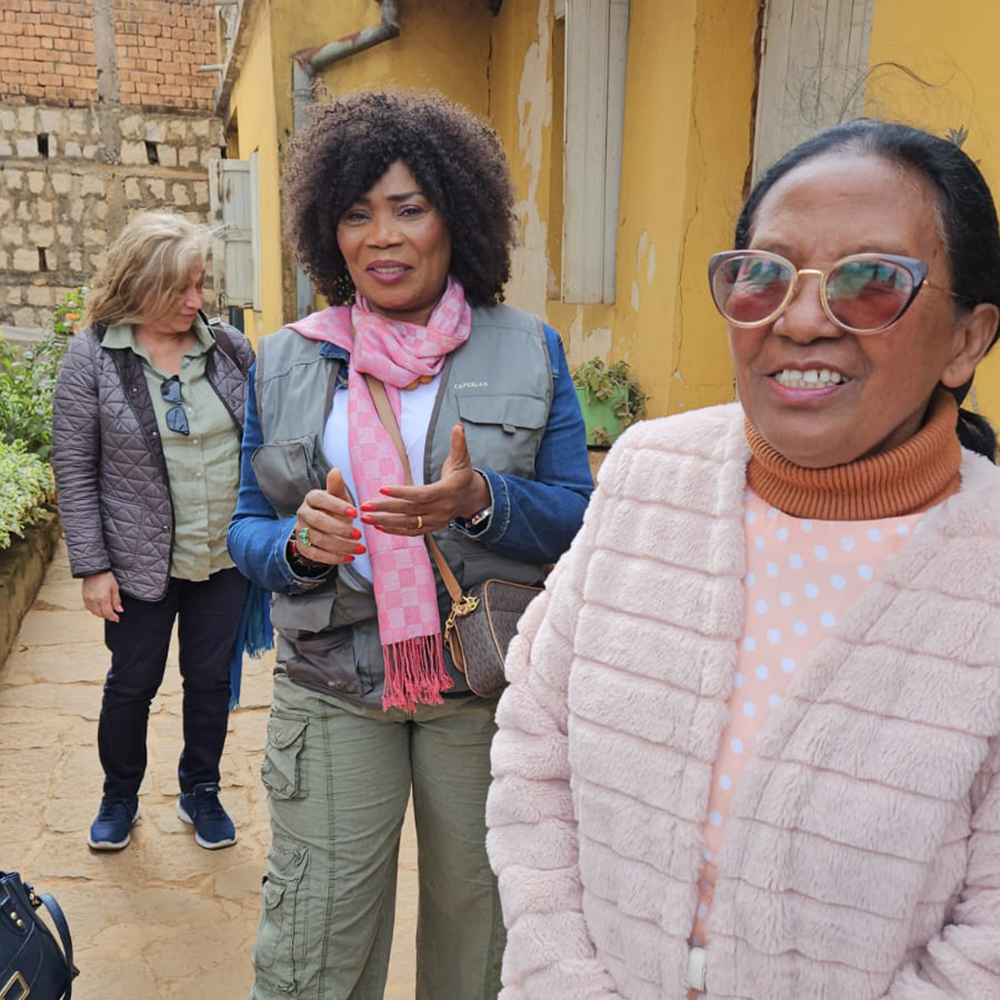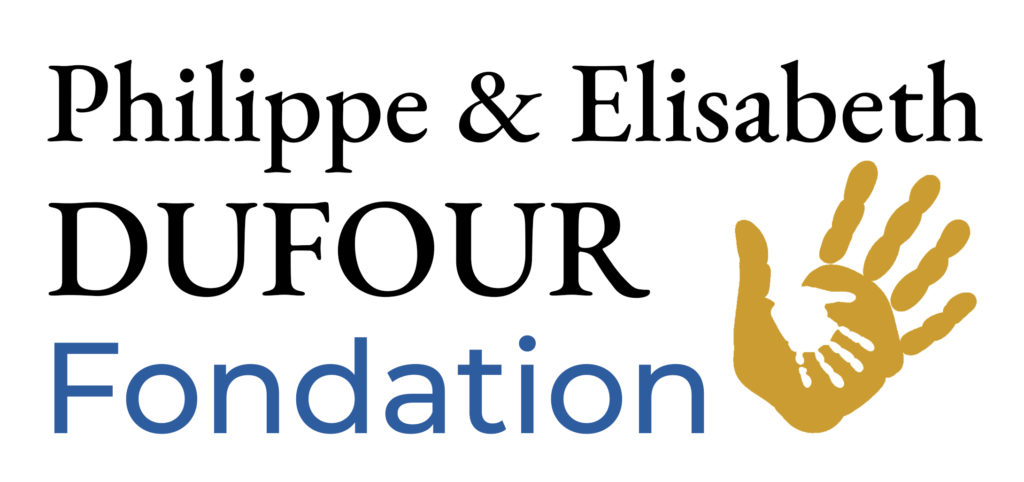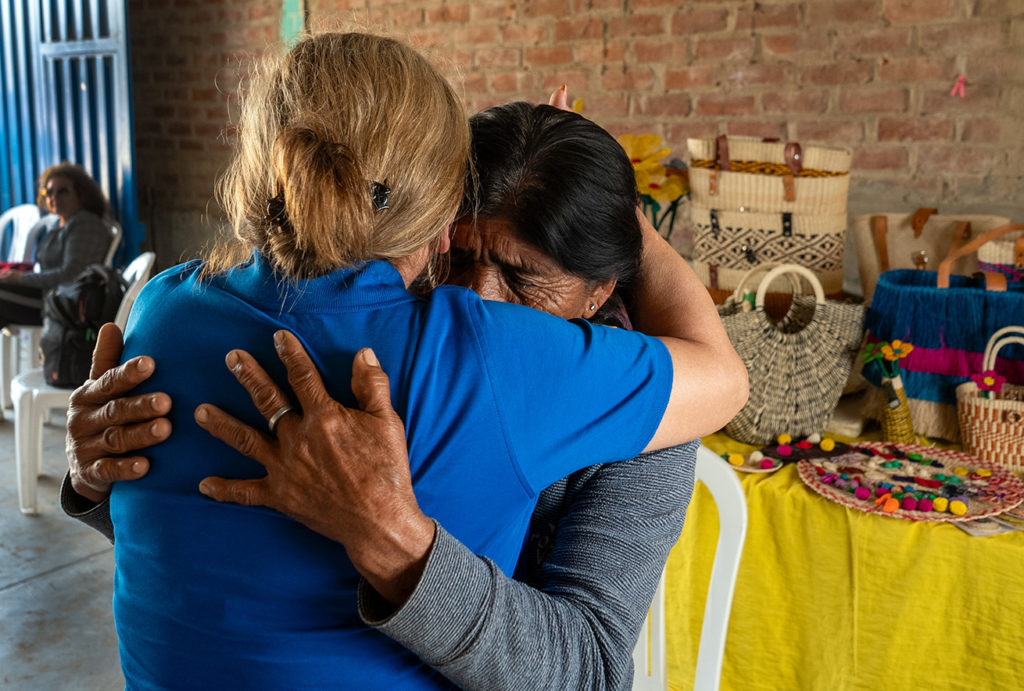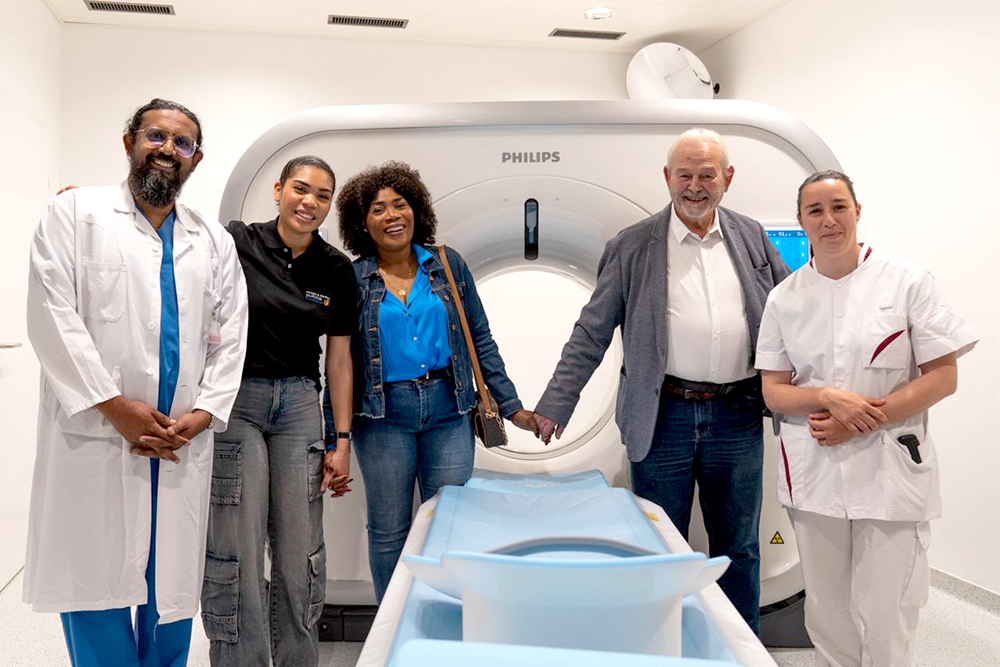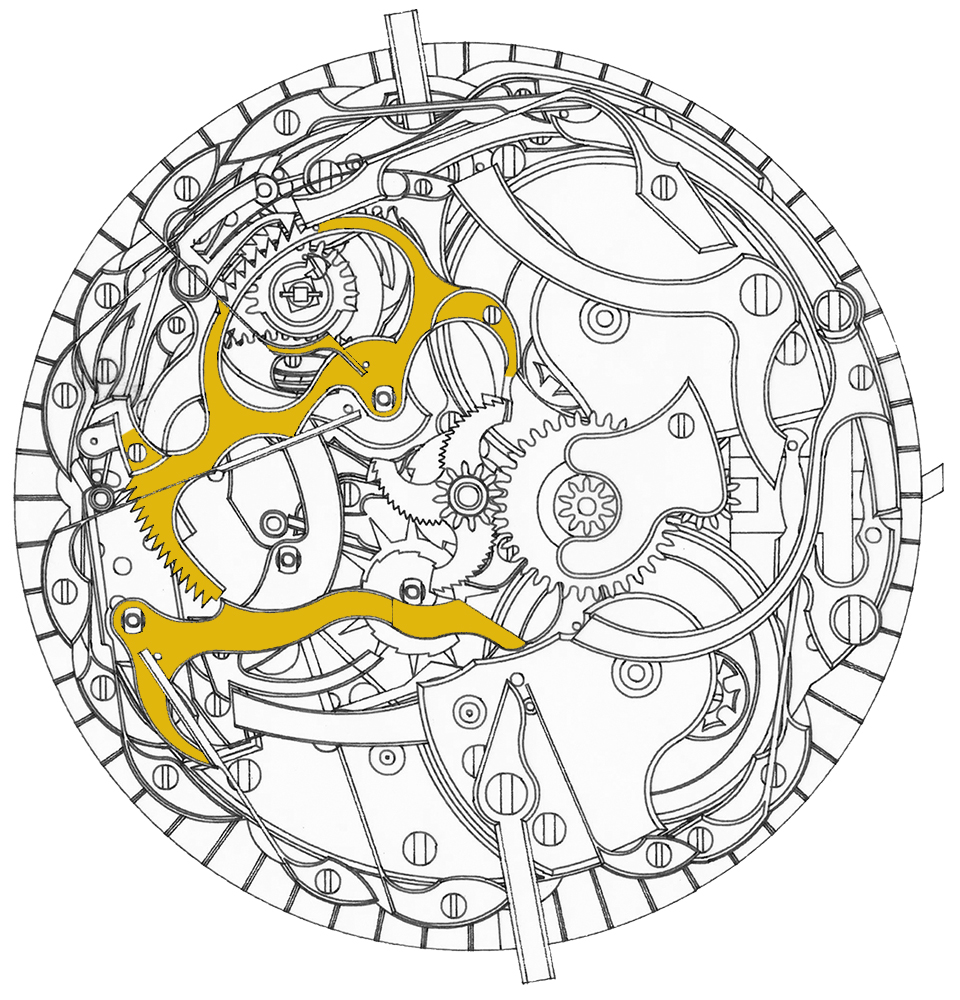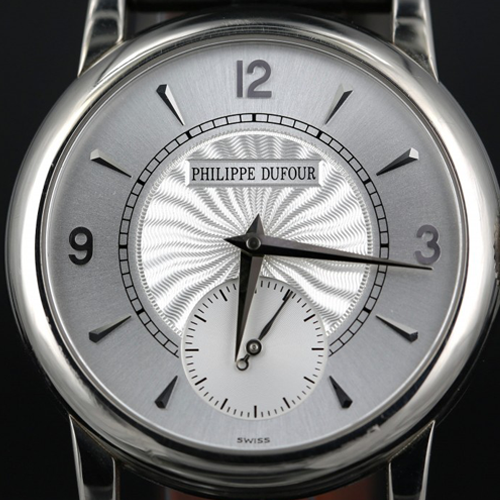My Journey: "Time Messenger"
Chance and Destiny
Although I am often placed at the pinnacle of mechanical watchmaking—an honor that deeply moves me—I never consciously chose to become a watchmaker. As a child, school held little appeal for me, and mathematics, in particular, seemed an insurmountable obstacle. My lack of interest in academics closed many doors, preventing me from entertaining grand ambitions.
On the other hand, I loved tinkering. My old Triumph motorcycle fascinated me far more than any schoolbook, and I had come to believe that mechanics might offer a path to the future. But in the Vallée de Joux, that remote land of the Swiss Jura where I grew up, career choices were limited. Born into a modest family and lacking the stature or physical strength to become a lumberjack, I had to find another way.
My parents then took me to the technical school of the Vallée, where a series of tests proved decisive. The teachers’ verdict was unwavering: "His head and hands work well, but his shortcomings in mathematics are too great to consider anything else. He can be a watchmaker." And so, without having sought it, my destiny was set.
Yet, within the first few months, the school became a revelation. We were taught to craft our own tools—objects shaped by our hands, precision instruments that would become extensions of our skill. Some of these tools, silent witnesses to my beginnings, still accompany me to this day.
I completed my four years of training with distinction, earning the title of horloger rhabilleur. The trade that had been assigned to me almost by default gradually became a true passion—an art where every gesture matters, where the hand extends the mind, and where time, far from being merely a mechanical measure, becomes a pursuit of the absolute.
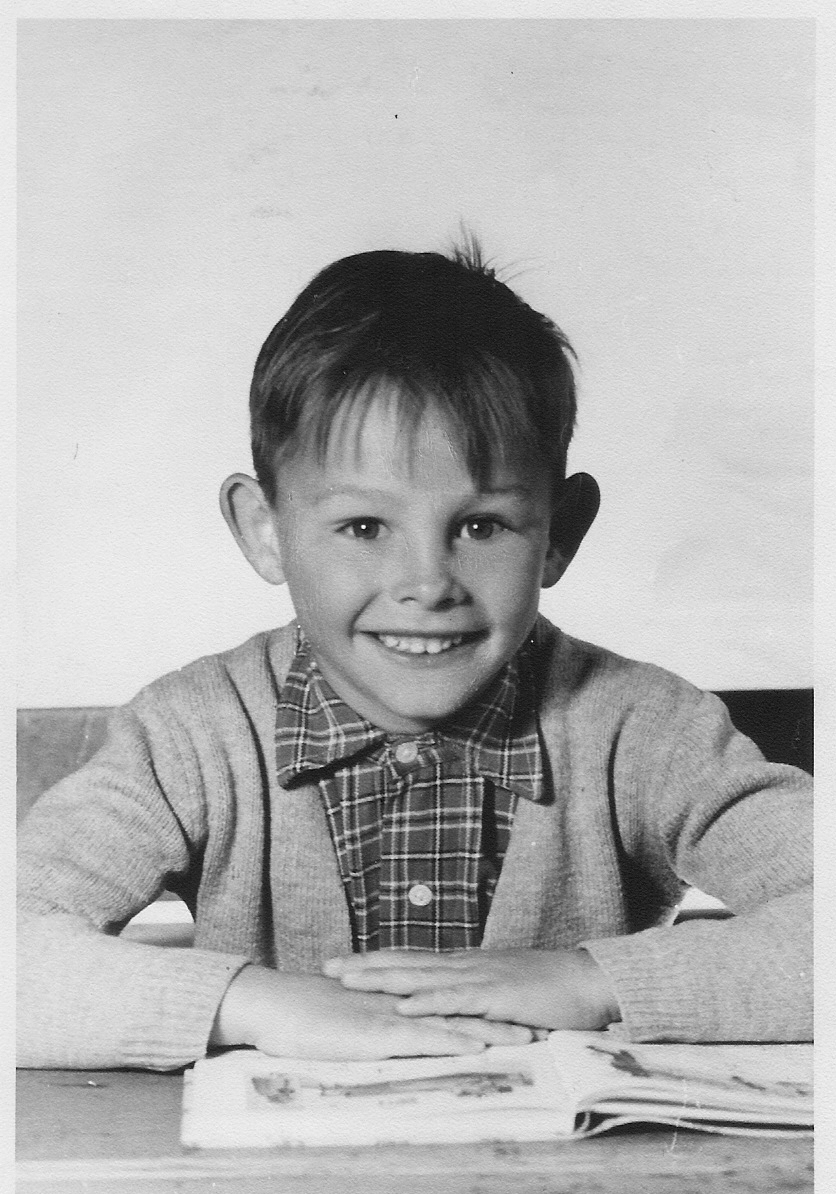
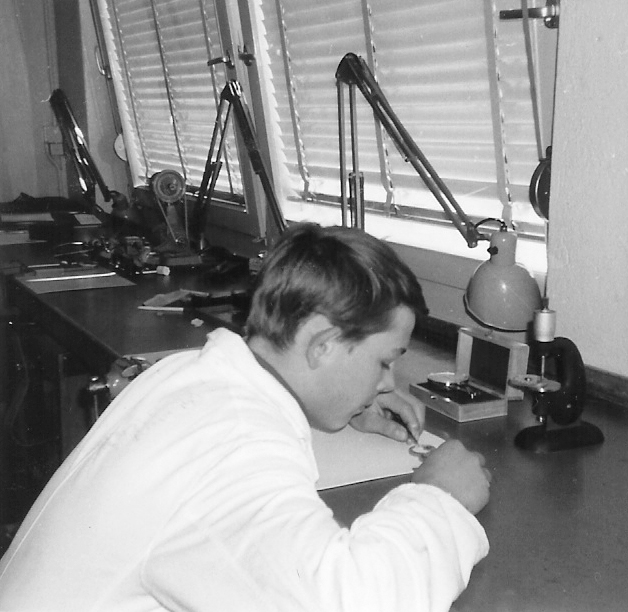

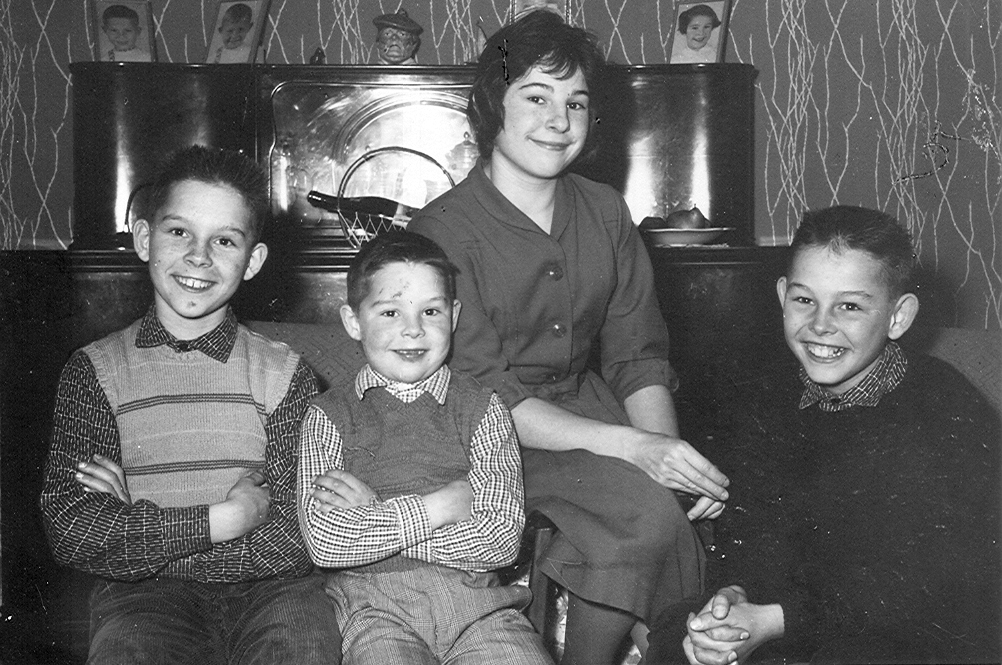

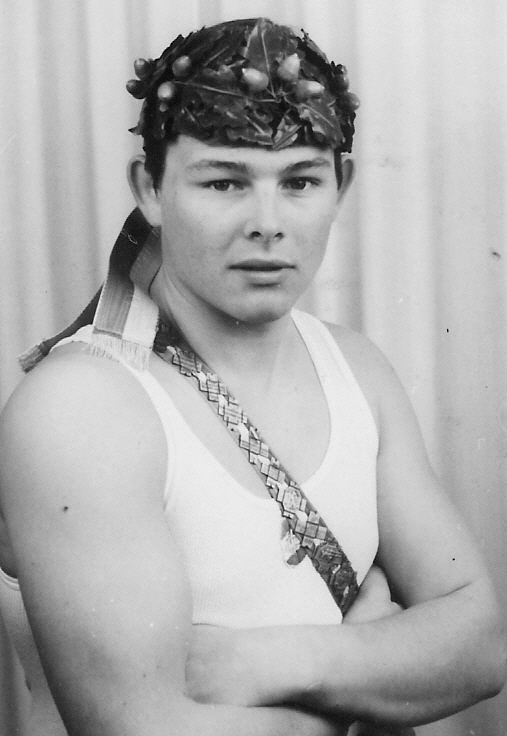
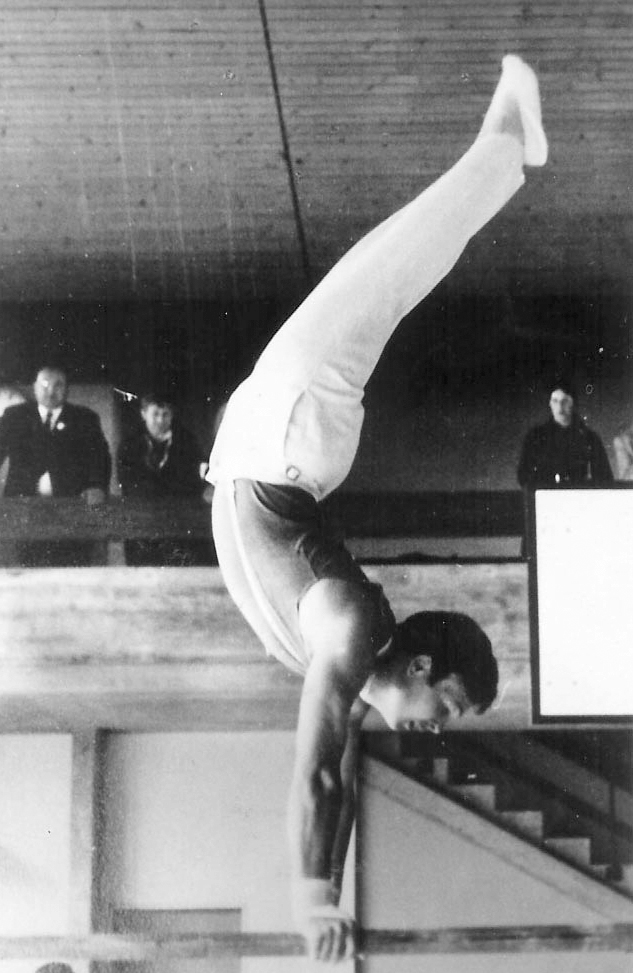
My Beginnings in the Professional Life
If mathematics was not my strong suit, languages, on the other hand, fascinated me. More than anything, I dreamed of leaving my valley, of setting out to discover the world. This thirst for elsewhere drove me to seek a job that would allow me to travel. That is how I joined Jaeger-LeCoultre in Le Sentier, with a crucial detail in my contract: the possibility of being sent abroad.
My first departure took me to Germany, where I spent a year in after-sales service. Then came England, at Favre-Leuba, which had recently been acquired by Jaeger-LeCoultre. There, my mission was more ambitious: to reorganize the after-sales service and train watchmakers. It was an enriching, though sometimes challenging, experience. Faced with customers dissatisfied with the reliability of their watches, I realized for the first time what a timepiece should be—not just a precision instrument, but a dependable companion, designed to last.
Back in Switzerland, I was entrusted with the responsibility of after-sales service for the first quartz watches. Yet, despite this promotion, the call of travel continued to haunt me. I kept searching for opportunities, and one day, a newspaper ad caught my attention— a company was looking for a watchmaker to lead a movement workshop… in the Virgin Islands.
Without hesitation, I embarked on this new adventure. Upon my arrival, I took charge of a workshop with fifty people, mostly women. But what struck me immediately was the atmosphere—a constant hum of conversation and bursts of laughter filled the space. It was nothing like the near-monastic silence of Swiss workshops.
One day, exasperated, I demanded that silence be restored. A worker then replied with a kind smile: "Here, if the lips don’t work, the hands don’t work either."
That phrase resonated with me. I learned to adapt to this different way of working, and, more importantly, I realized that watchmaking was not confined to the Vallée de Joux. It was not solely Swiss—it was universal.
Return to Switzerland
After years of adventure and discovery, it was time for me to return to my roots—to the Vallée de Joux, which, despite my longing for elsewhere, remained my anchor.
Back in Switzerland, I spent a year at Gérald Genta, immersing myself completely in traditional artisanal craftsmanship. There, each piece was shaped with a meticulous attention to detail that fascinated me. Then, I joined Audemars Piguet as a flat movement regulator, further honing my expertise.
The desire to explore new approaches then led me to Comor Watch, where I was tasked with showcasing minute repeater movements through sophisticated decorations. But the adventure was short-lived—within a year, differences with the owner brought our collaboration to an end.
I did not know it yet, but this failure would mark a decisive turning point in my career.

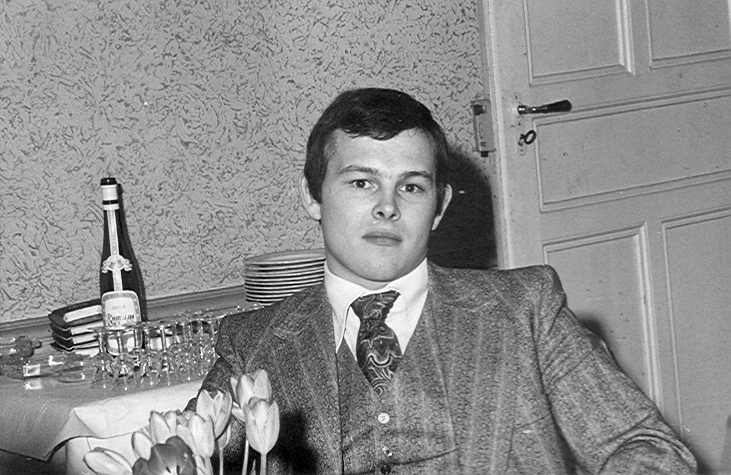
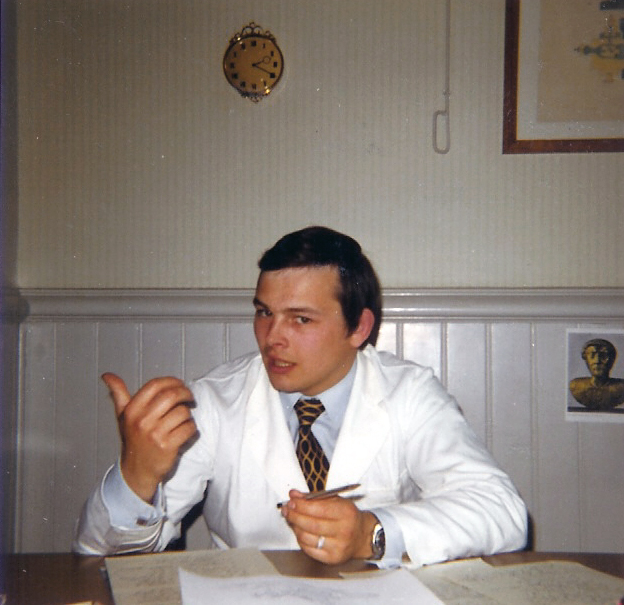
The Great Turn to Independence
Following my setbacks with Comor Watch, an unexpected opportunity arose—I bought the workshop, and in the span of a single day, I became an independent watchmaker.
Alone, with no safety net, I set out in search of clients. My first great opportunity came from Geneva, with the renowned auction house Galerie d’Horlogerie Ancienne, which would later become Antiquorum. For more than five years, I restored complicated pocket watches there, uncovering beneath each dial mechanisms of astounding ingenuity. Regardless of their origin—Swiss, German, or English—one constant became evident to me: seven times out of ten, the heart of these watches beat to the rhythm of complications born in the Vallée de Joux.
The more I restored these masterpieces of the past, the more an idea took root within me: what if I created my own complicated pocket watch? This challenge, which seemed utterly audacious, became an obsession. I decided to devote all my free time—my days off, my vacations—to crafting the most noble of complications: the Grande Sonnerie.
But a movement, no matter how sophisticated, cannot exist without a case worthy of it. Lacking the means to commission a case befitting my work, I opted for a brass casing—modest, yet sufficient to present my creation to potential investors. Alas, every door remained closed. Everywhere, refusals piled up. I was advised instead to take my project to a major watchmaking manufacture, one that could bring it to life.
Audemars Piguet showed interest and commissioned five pieces from me—an unexpected opportunity, but one that would demand thousands of hours of work. Each watch required over 2,000 hours of labor, meaning an entire year of meticulous and relentless effort per piece.
At last, the work was completed. But what should have been a moment of triumph turned into disillusionment. One day, Audemars Piguet summoned me—there was a problem with two of the watches I had delivered.
When I saw them, my blood ran cold. One was half-shattered, the other nearly destroyed. An indescribable shock. How could anyone treat pieces born from thousands of hours of labor this way? How could there be such a lack of respect for an artisan’s work?
That day, I made a vow: never again would I work for someone else. This time, the decision was final. From that moment on, my work would depend on no one but myself.
Jumping into the Void
Faced with disappointment and anger, only one option became clear: to strike back, and strike hard. I then made a radical, almost reckless decision—in the utmost secrecy, I would design a Grande Sonnerie… but for the wrist.
I was alone. No major manufacture had ever ventured into this territory. No watchmaker, no matter how prestigious, had dared to take on such a challenge. Yet I, a humble independent, was ready to devote myself to it, body and soul.
But a project of this magnitude required time and resources. As so often, I had to seek support beyond Switzerland. No one is a prophet in their own land… and it was in Italy that I found a patron—an investor who provided me with the financial oxygen needed to bring this monumental endeavor to life.
Two and a half years of relentless work followed. Two and a half years of pushing the boundaries of mechanics, of reinventing what had never been done before. Finally, in 1992, I unveiled my creation at BaselWorld—a world first, yet displayed in complete anonymity.
What a paradox—to achieve the impossible, to accomplish a groundbreaking technical feat, and yet… remain invisible.
But the worst was yet to come. I soon discovered the other side of the industry—a world no longer driven by watchmaking excellence, but by marketing and financial interests. Dishonest offers poured in. I was urged to sacrifice my independence, to enter a system where the value of a timepiece was no longer measured by the quality of its movement, but by the power of a brand.
I was on the brink of the abyss, financially suffocated, but I refused to yield to the siren call.
To make matters worse, serious tensions erupted with my Italian partner. A legal battle ensued. Lawyers were involved, compromises had to be made, but above all, it took unwavering determination to secure an agreement and keep the adventure alive.
But against all odds, I held firm.
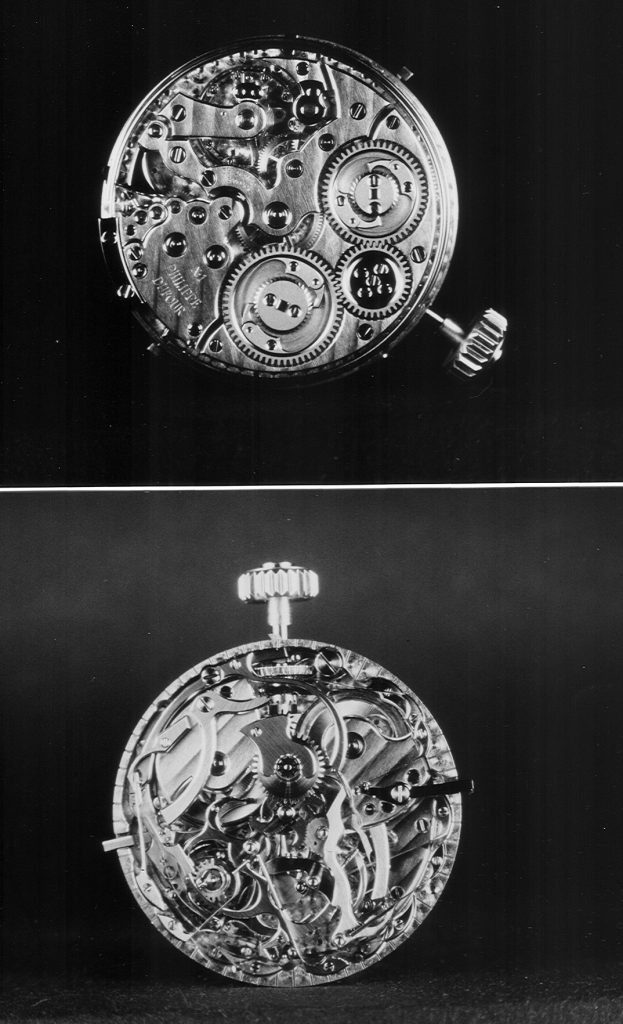
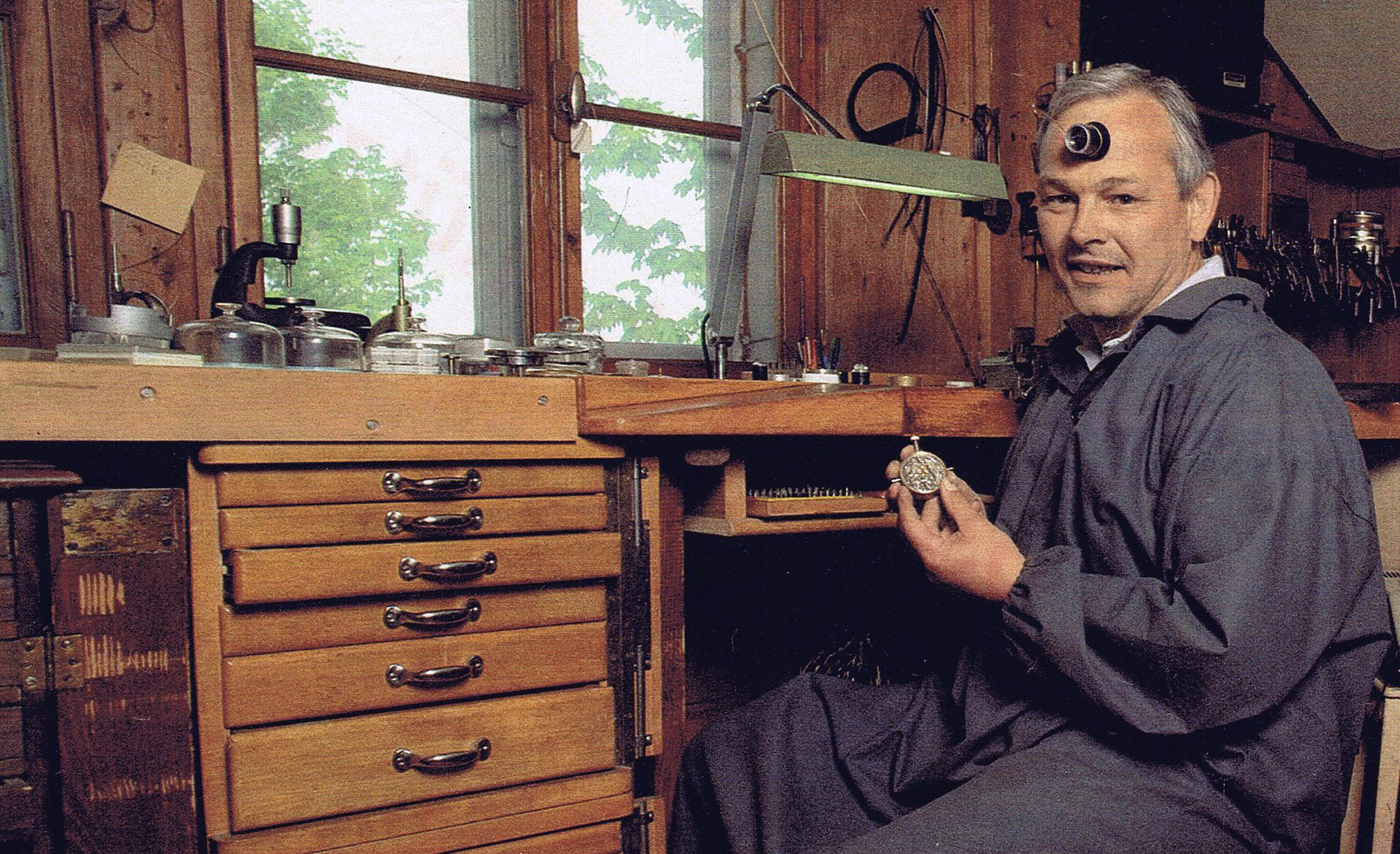

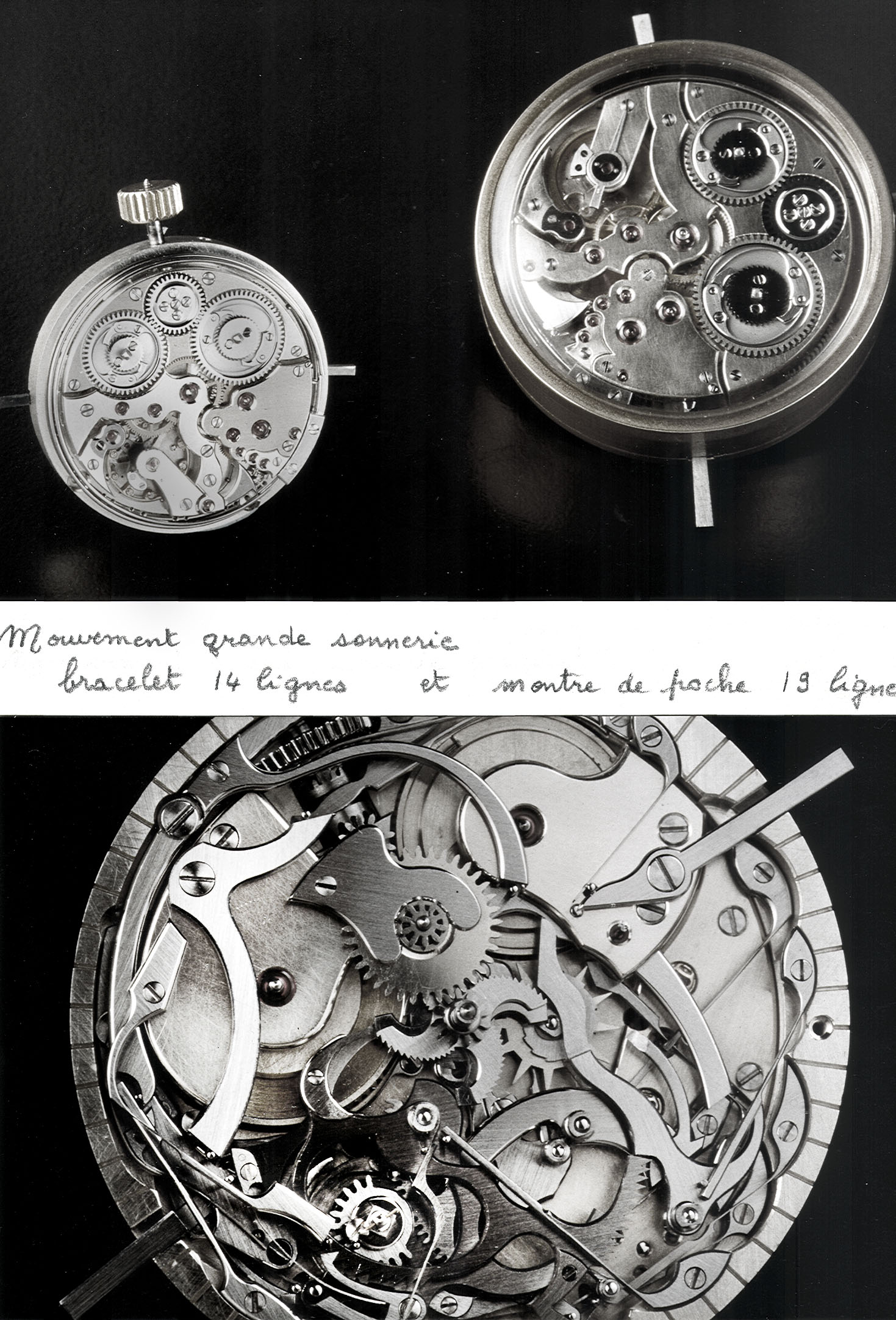
Independence and Recognition
Continuing under such conditions required extraordinary strength of character. Perhaps it was my origins, or the upbringing I had received, that had shaped me this way. Never sell out. Never give in.
And then, when everything seemed uncertain, recognition came… from the other side of the world.
What I did not know at the time was that Asia would play a fundamental role in my story. Once again, no one is a prophet in their own land, and I realized that this truth extended far beyond Switzerland and the Western world.
I had the opportunity to present two of my pieces in Singapore:
- The Grande Sonnerie No. 1 in a pocket watch,
- The Grande Sonnerie No. 1 in a wristwatch.
Ten days. Ten days of discussions, meetings, and passionate exchanges.
At the end of this intense period, both of my pieces found buyers. But more than that, three new orders were placed… with nothing more than a handshake. No endless contracts, no lawyers, no absurd clauses. Just a given word—and in Asia, a given word still holds meaning.
Nothing has ever felt more authentic, more noble than those moments when human relationships take precedence over everything else. To do everything myself, from conception to sale—that is true independence.
I then learned that in these countries, particularly in China and Japan, great importance was placed on craftsmanship, on the handmade, on excellence. There, the values that had always guided my work—authenticity, honesty, and tenacity—found a natural resonance.
And for the first time, I realized that my independence was not a constraint, but a strength.

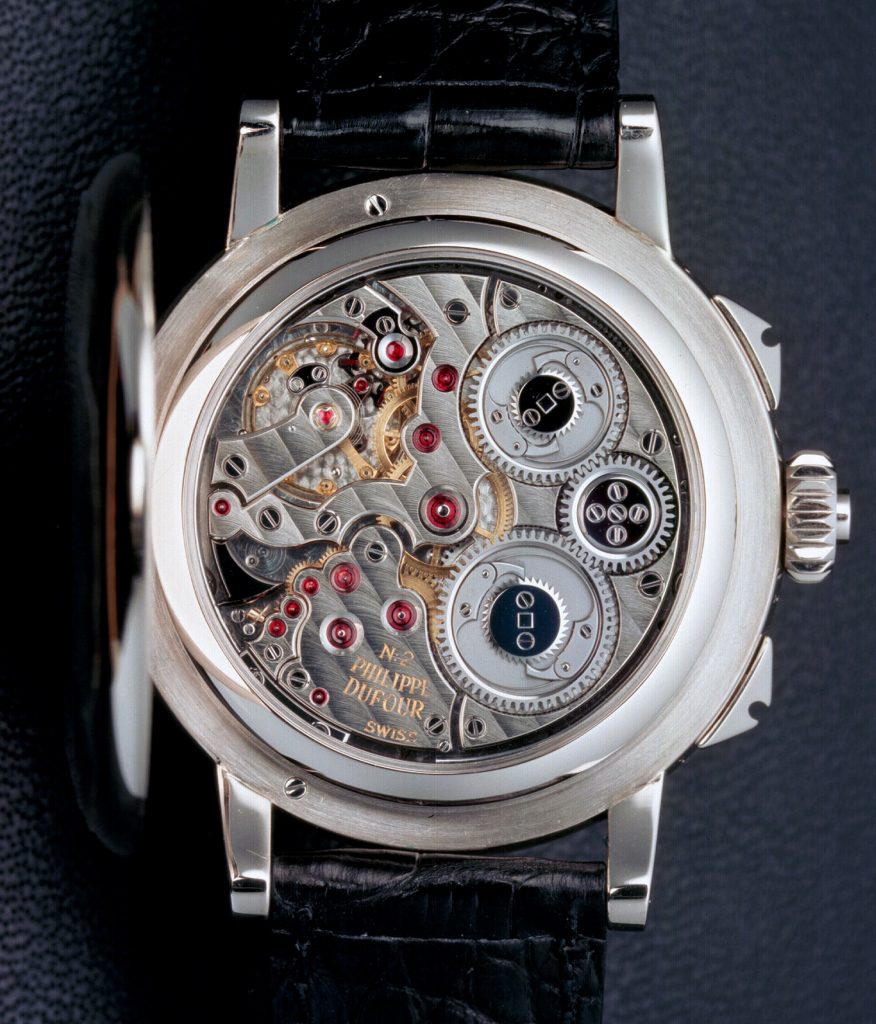
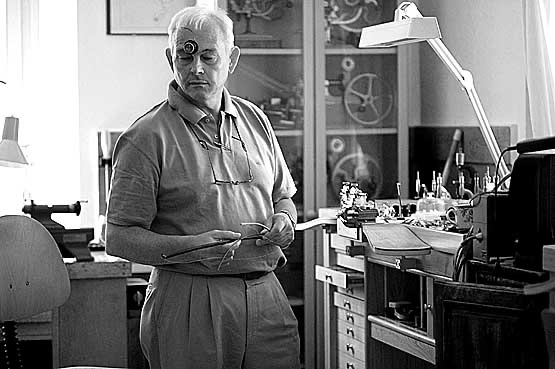
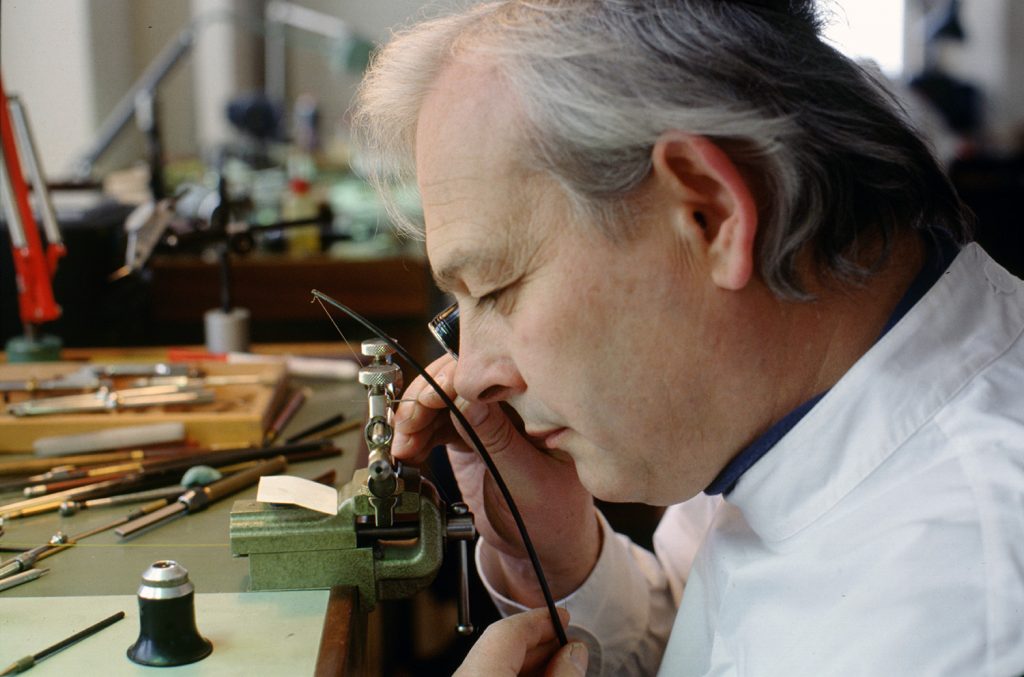
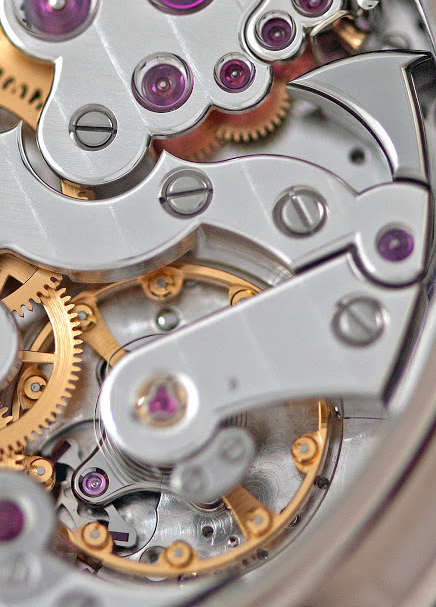
Inspiration from my Peers
In 1996, after achieving the impossible with my Grande Sonnerie, I needed a new challenge—a worthy successor to my first timepiece. But I was determined to avoid the trap of ease: there was no question of creating yet another tourbillon, which had become little more than a passing trend. And let’s be honest—the tourbillon has no real purpose in a wristwatch.
It was then that I embarked on a true journey through time. I unearthed old catalogs, notably those from the Rockford Time Museum, dating back to the 1930s. There, I rediscovered the legacy of the great watchmakers of the Vallée de Joux—an era when watchmaking was still passed down as a living art.
At that time, true masters taught with passion in watchmaking schools. They shaped future generations through école watches—unique pieces where each student showcased their talent and ingenuity. As I explored these treasures of the past, I came across école watches with double balance wheels.
The inspiration was immediate.
But understanding this architecture required far more than theory. To grasp all the subtleties of this mechanism, I had only one solution: to craft it myself.
I then set out to design a groundbreaking prototype, integrating a new differential to balance the two balance wheels. For months, I experimented, adjusted, and tested until I fully mastered this technical complexity—a system in which the two balance wheels interact, their rate differences compensated to achieve exceptional chronometric precision.
When everything was finally perfected, I was able to dedicate myself to the final construction of this revolutionary timepiece. It was the culmination of a long journey, where tradition and innovation merged in perfect harmony. From this passionate quest was born an exceptional watch: the Duality.
Only nine pieces came to life, each carrying within it the legacy of a forgotten craft, revived by an independent watchmaker who refused to follow trends and compromises.



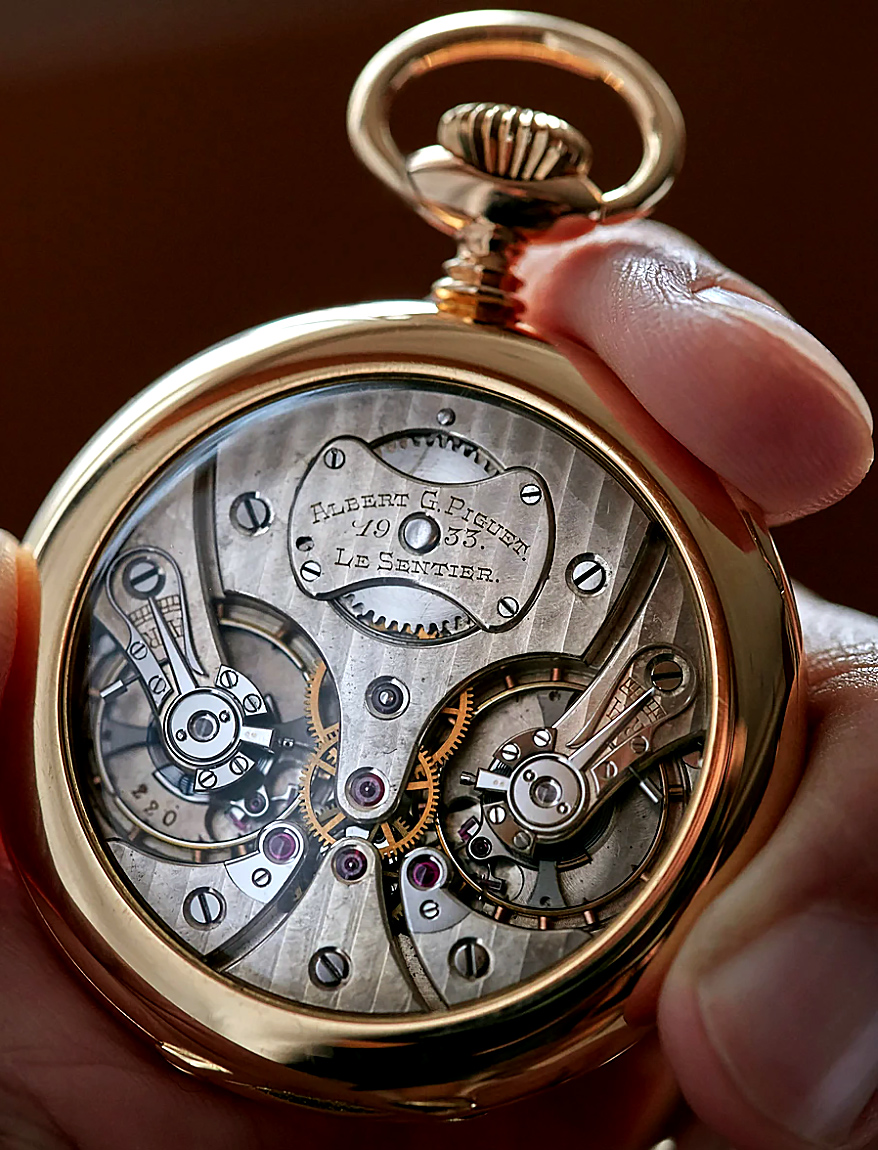
The Complexity of Simplicity
The birth of the Simplicity was a story of its own. It did not stem from market research or strategic planning but from a deep desire… and a call from Japan.
In Tokyo, a Philippe Dufour fan club had formed, and its members challenged me: to create a simple watch… but one of absolute perfection.
This idea had captivated me for a long time—to design a three-hand timepiece with a timeless, refined aesthetic, featuring a movement capable of enduring the centuries without faltering.
I drew my inspiration from the watches of the 1950s and 1960s—timepieces I had been fortunate to restore throughout my career, whose robustness had always impressed me. The key lay in the proportions: 30 mm in diameter, a 12-ligne caliber—the ideal dimensions to ensure near-indestructible mechanical reliability.
And the challenge was met.
When the first Simplicity watches returned to my workshop for routine servicing, I was amazed to see that, once wound, they ran almost better than when they were brand new.
Unveiled in 2000, the Simplicity immediately sparked immense enthusiasm, particularly among Japanese collectors.
Rather than going through a traditional distribution network, I made a bold choice: I decided to work directly with a single retailer, Shellman Watch & Jewelry in Tokyo. This meant several trips to Japan, where I had the opportunity to meet my clients in person, in the boutique, to exchange with them, to speak about my work.
It was a revelation.
There, I discovered extraordinary enthusiasts—watch lovers for whom every detail has meaning, for whom authenticity, craftsmanship, and artisanal excellence are essential values. They are not merely looking for a watch; they seek a true work of art, created with passion and dedication.
In Japan, I found a profound respect for craftsmanship and expertise. I discovered collectors who quite literally live with their timepieces, forging an almost spiritual connection with their watches.
One day, during one of my visits, a doctor invited me to his office. On the walls, there were no diplomas… but photographs of all my watches. This passionate collector didn’t just admire his Simplicity—he even lent it to his patients, allowing them to experience firsthand what a truly exceptional timepiece feels like.
The emotion was overwhelming when he asked me to sign photographs for his patients—the very ones who had been fortunate enough to wear his watch. I will never forget that moment.
Japan became my benchmark market. Of the 200 Simplicity watches produced, 120 found owners in the Land of the Rising Sun. More than that, this market opened the doors to all of Asia, serving as a springboard to collectors who share the same values of authenticity and excellence.
My relationship with Japan did not end there. I was invited several times to the Hiko Mizuno watchmaking school in Tokyo to teach courses on horological decoration.
The welcome from both professors and students was incredible. These young watchmakers, passionate and respectful, had an insatiable thirst for learning. In that moment, I realized that, in a way, the circle had come full circle—after drawing my own inspiration from the masters of the past, I was now passing on my knowledge to a new generation.
And thus, authentic watchmaking continues to live on.
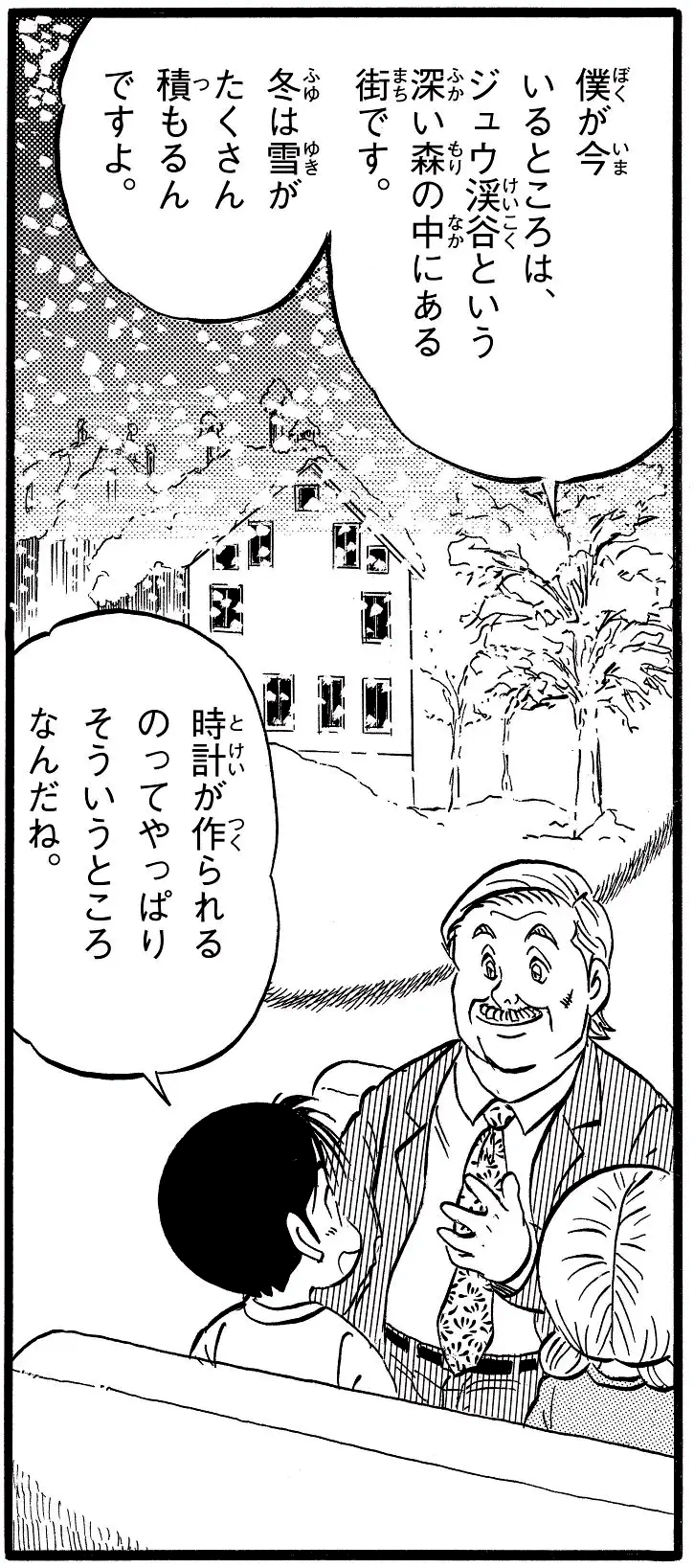
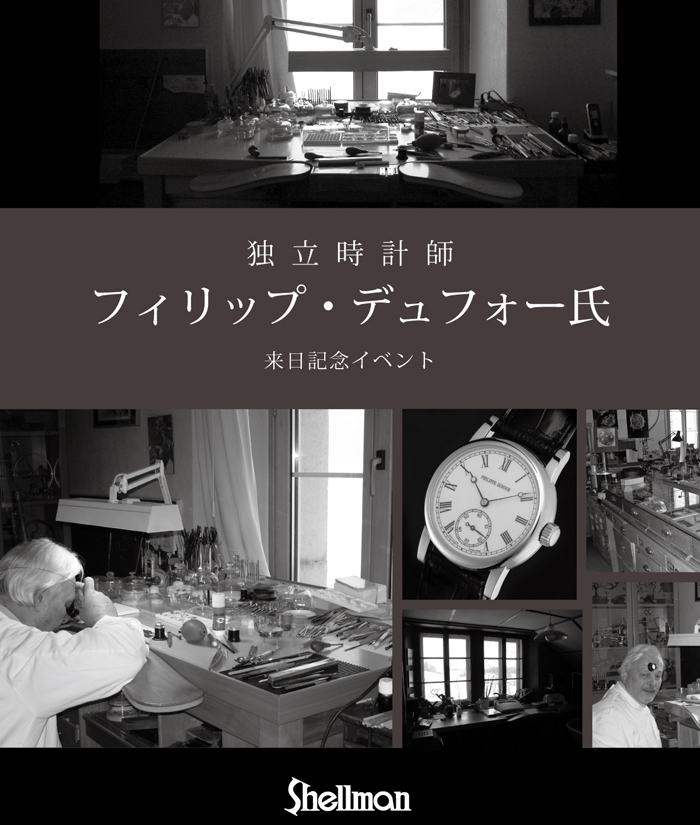
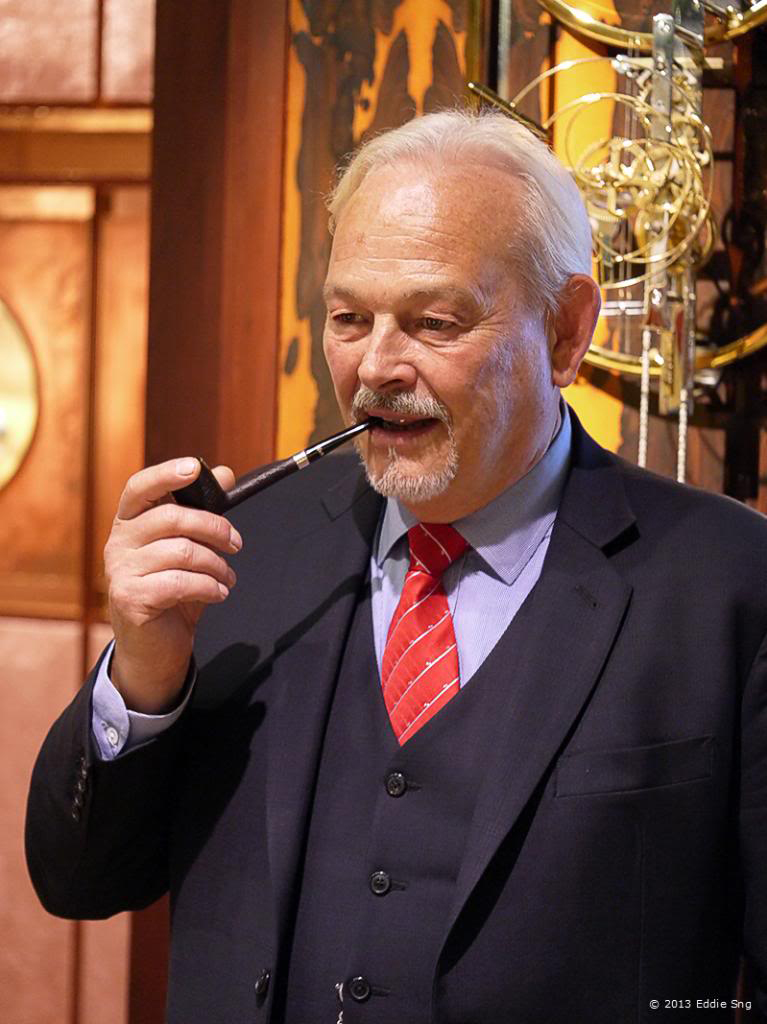
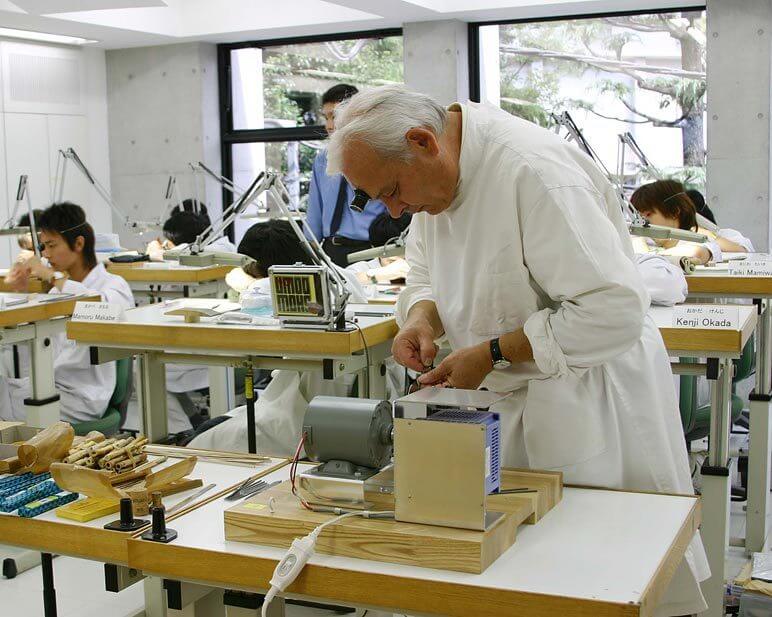
Tribute to a Master
In a career, there are encounters that change everything—friendships that go beyond the confines of work. For me, Gabriel Locatelli was not just a colleague; he was a mentor, a master, a brother in the workshop. When I graduated from watchmaking school in 1967, I joined Jaeger-LeCoultre to refine my apprenticeship. Gabriel was my first colleague, but he quickly became much more than that. He took me under his wing, passing on not just a skillset, but a mindset, a discipline, a philosophy.
Our paths first diverged when I left for Frankfurt, where I discovered the reality of after-sales service and the challenges faced by customers. But upon my return, our reunion felt natural, and I had the privilege of working alone with him in a laboratory workshop. We were tasked with improving and developing movements, fine-tuning adjustments, studying lubrication and performance—finding solutions to problems no one else noticed. For example, we researched how the oils in display watches degraded under UV exposure, leading to a loss of amplitude. Our mission was to invent solutions, to push the boundaries of watchmaking ever further. It was fascinating work, requiring extreme precision—a true companionship where every day was a pursuit of perfection.
But one day, our paths parted once again. I had another calling, another ambition—to move from refining movements to creating timepieces. Time passed, and much later, in 1992, our paths crossed again. Gabriel, disillusioned and worn down, no longer recognized the world of watchmaking. The era of technocrats and industrialists had disfigured the craft. The fragmentation of labor had replaced the complete artisan; the watchmaker was no longer a creator but merely an executing hand, confined to a single task, stripped of all creative expression. His assessment was bitter.
One day, he said to me, "As soon as I retire, I’m coming to work with you." And he kept his word. The day he was free, I called him: "Your workbench is ready." He returned. His arrival coincided with the beginning of a project that would change everything: the Simplicity. The years we spent working together were an absolute joy—a renewed harmony, just like in our first laboratory workshop.
Then came the year 2000. I presented the Simplicity in Basel, where it immediately sparked phenomenal enthusiasm, particularly among Japanese collectors.
A few months later came a day I never wanted to face. The news struck like a hammer blow—Gabriel was gone. A car accident, sudden, brutal, incomprehensible. I was devastated. His passing left an immense void, a heavy silence in the workshop, where every tool, every workbench still bore his presence. For weeks, I was unable to return to work. I even considered stopping everything—continuing without him felt impossible.
But deep inside, I knew. I knew he would never have wanted that. I knew he would have been the first to encourage me to keep going..
I understood that I had to continue. Because this project carried a part of him—through everything he had taught me, through the knowledge he had patiently shared, through a legacy that could not be allowed to fade. Stopping would have broken that continuity, letting a heritage shaped with rigor and passion be lost. Because every Simplicity, in its pursuit of perfection, in its meticulous attention to detail, extends that legacy with the same unwavering dedication.
The world of watchmaking and the Vallée de Joux have lost an absolute master, a man who left his mark on history through his talent and humility. Yet, like a well-crafted timepiece, his legacy will continue to withstand the test of time. In the end, he has not entirely left my workshop, for I still feel his presence. Gabriel Locatelli lives on through each of my gestures.
Time aeon Foundation
In 2003, an urgency became clear to me—an undeniable truth that had to be faced head-on: preserving a watchmaking art in peril.
Les savoir-faire traditionnels, ces gestes minutieux transmis de maître à élève depuis des siècles, étaient menacés. L’industrialisation et l’automatisation, si elles apportaient rapidité et rendement, effaçaient l’âme même de l’horlogerie. Car aucune machine, aussi avancée soit-elle, ne pourra jamais rivaliser avec la précision, la sensibilité et la poésie des mains humaines, armées de micro-burins, d’archets et d’outils façonnés par des générations d’artisans.
I have always said it: the true essence of watchmaking lies in the intelligence of the hand. It is the hand that upholds excellence, blending precision, creativity, and transmission in an unrelenting pursuit of perfection.
Thus was born the Time Aeon Foundation, an initiative dedicated to preserving and passing down these exceptional artisanal techniques. More than just a commitment, it is a duty—a fight to ensure that this universal legacy does not fade away.
Through this foundation, we aspire not only to shine a light on this craft but also to inspire a new generation of watchmakers—future guardians of this knowledge. A knowledge that must not only be preserved but also evolved, ensuring its place in contemporary watchmaking without ever compromising its authenticity.
Birth of a Watch
This bold and unprecedented project was born in 2009, through discussions with my wife, Élisabeth, and Robert Greubel, accompanied by his wife, Sylva. These exchanges, often shared over lunches or dinners., ont peu à peu façonné cette idée.
At the end of these meetings, my wife strongly encouraged me to embark on this journey—a reflection that had been growing within her for a long time. To her, this project was far more than just an initiative; it was a necessity to ensure the longevity of a precious craft. At the time, I had no successor to whom I could pass down the legacy of my workshop and the Philippe Dufour brand. Her conviction and unwavering support were decisive in my decision to take the leap.
Thus, the Time Aeon Foundation naturally emerged as the rightful bearer of this project. Bringing together watchmakers who shared the same vision, it set out on a mission to preserve and pass down traditional craftsmanship, threatened by the growing industrialization of watchmaking. This framework provided our ambition with a broader reach and a solid structure to ensure its success.
The objective was clear: to pass down exceptional craftsmanship through the creation of a timepiece made entirely by hand, from the initial sketches to the finished piece.
To embody this pursuit, we needed a passionate and dedicated watchmaker—someone capable of mastering these ancestral techniques and carrying them forward. The choice fell on Michel Boulanger, a watchmaking professor at the Lycée technique Diderot in Paris. His expertise, humility, and precision made him the perfect ambassador for this extraordinary project.
But Naissance d’une Montre was not merely a reconstruction of the past. It was a resolutely contemporary endeavor, aimed at proving that handcrafted watchmaking still has its place in the 21st century.
The project was meticulously documented, published on a dedicated website, and showcased at the most prestigious watchmaking exhibitions, including the SIHH. The specialized press widely covered it, and the response was overwhelmingly enthusiastic.
Visitors, collectors, and journalists quickly grasped the crucial importance of this initiative: showcasing the extraordinary richness of handcrafted work, demonstrating the significance of transmission, and, above all, raising awareness of the challenges facing traditional watchmaking.
Michel Boulanger rose to this monumental challenge with brilliance, and through his work, he upheld the values of artisanal excellence.
We believed we had laid the foundations of an unshakable journey. But, alas, history had other plans…


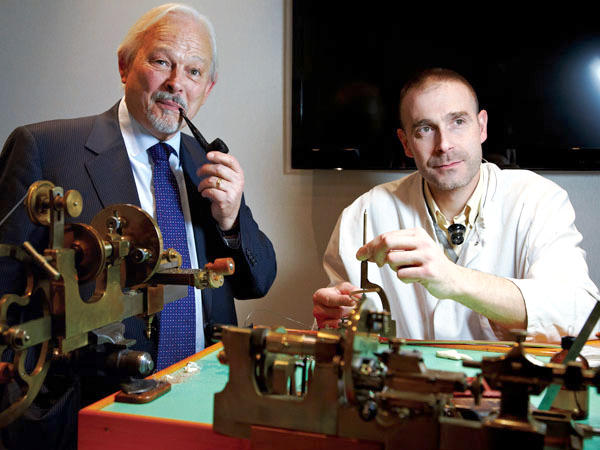
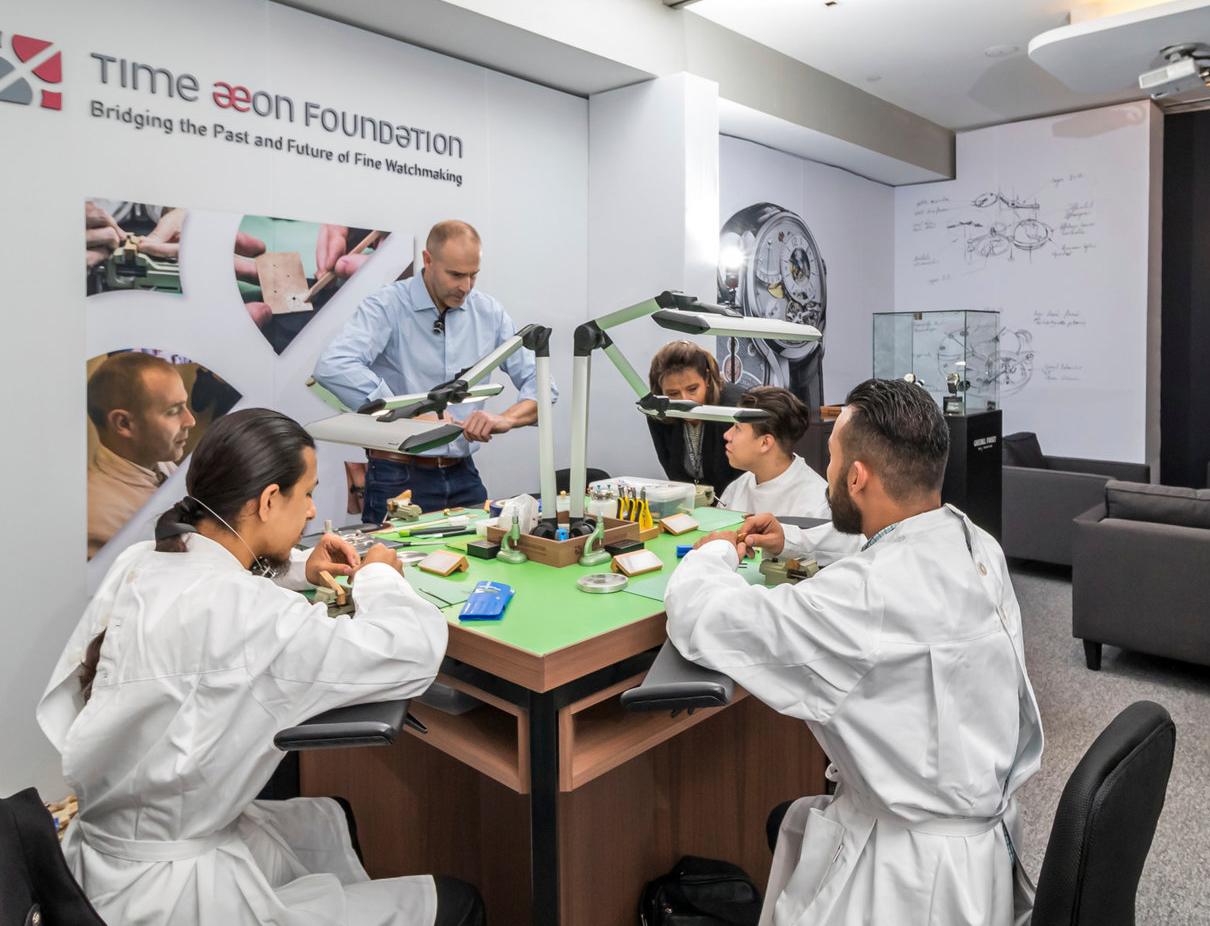

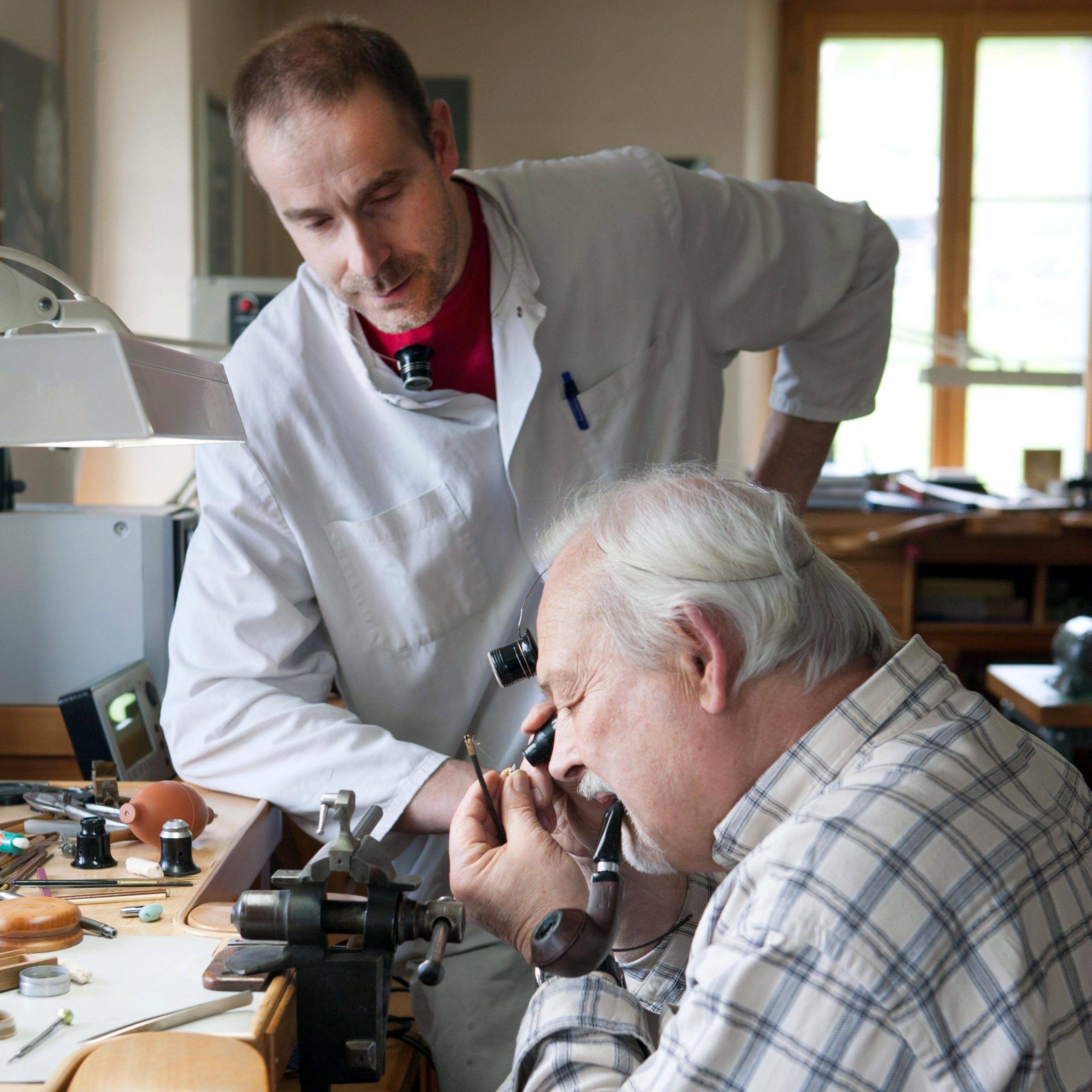
A shadow on the canvas
Despite the initial enthusiasm and the recognition it garnered, Naissance d’une Montre was marred by human setbacks that deeply wounded me.
In a project as ambitious as this, differences of opinion and disagreements are inevitable. But what happened went beyond mere misunderstanding. Certain behaviors betrayed the fundamental values that, to me, are the very soul of artisanal watchmaking: discipline, humility, and respect.
A promise that was particularly close to my heart was not honored. A timepiece was meant to be returned to me in recognition of the efforts I had devoted. I would have been proud to showcase it in my workshop, during visits or at international events, and I had hoped, one day, to donate it to a watchmaking museum as a timeless testament to the artisanal craftsmanship of our art. But that promise faded away, taking with it far more than just an object—it carried away a mark of respect, a symbol of loyalty, and a part of the very soul of this adventure.
With hindsight, what I feel is immense sadness. This project, which was meant to celebrate the purity of craftsmanship, was tainted by betrayals and attitudes incompatible with the collective spirit and dedication we had poured into this mission.
These failures were all the more painful because they went against everything we sought to uphold. We aimed to preserve a craft, to inspire a new generation, yet some chose to undermine this momentum—whether out of selfishness or a lack of loyalty.
The injustice of these actions tarnished what could have been a memorable chapter in artisanal watchmaking.
But, as with any challenge, lessons must be learned. This experience reminded me that watchmaking excellence is not solely about mastering techniques. It demands absolute integrity, genuine commitment, and unwavering loyalty to fundamental values.
Though Naissance d’une Montre now bears a regrettable mark, it remains a cornerstone of my journey.
I remain convinced that the future of artisanal watchmaking is not merely about preserving craftsmanship. It also relies on passing down fundamental human principles—without which no art, no matter how noble, can endure.
A family, a workshop, an undeniable truth
Some things are not decided; they impose themselves as an undeniable truth, born from a natural alchemy, a perfect balance between people. My workshop is far more than just a place of work—it is a family affair, a space where transmission, precision, and passion intertwine, a world where each person has found their place with an almost instinctive harmony.
Over the years, it became clear that to keep this legacy alive, a new structure was needed. With her keen management skills and strong communication abilities, Élisabeth naturally took the helm of the company. She became its pillar, bringing a fresh dynamic, organizing, anticipating, and ensuring that every cog in the workshop runs with exemplary fluidity. Thanks to her, I can now dedicate myself entirely to my craft—without compromise, without having to step away from what I love most: creating, perfecting, and pushing the boundaries of what is possible.
By my side, our daughter Danièla has found her place just as naturally. Passionate and demanding, she is far more than an assistant—she is a skilled watchmaker, embodying the precision and excellence that have always defined the workshop. Between us, a unique relationship has taken shape, blending transmission and complementarity. She observes, learns, and gradually brings her own vision, infusing new energy while honoring the very essence of my work.
Today, we embody the strength and soul of the workshop. Each of us plays a role, each contributes to this edifice of excellence and passion. This is not just a business—it is our home, where watchmaking is not merely a profession but a way of life. Every decision, every project is driven by the same ambition: to preserve a rare craftsmanship while remaining true to the values that unite us.
My story is not that of a man alone, but of a family united by a shared pursuit of excellence. This harmony, so natural and so powerful, is what allows us to shape our future with complete confidence.
This familial foundation and new structure have brought the workshop invaluable stability and strength. It is with this confidence that we approached a pivotal moment—one that would mark the history of our maison in a way we could never have imagined…

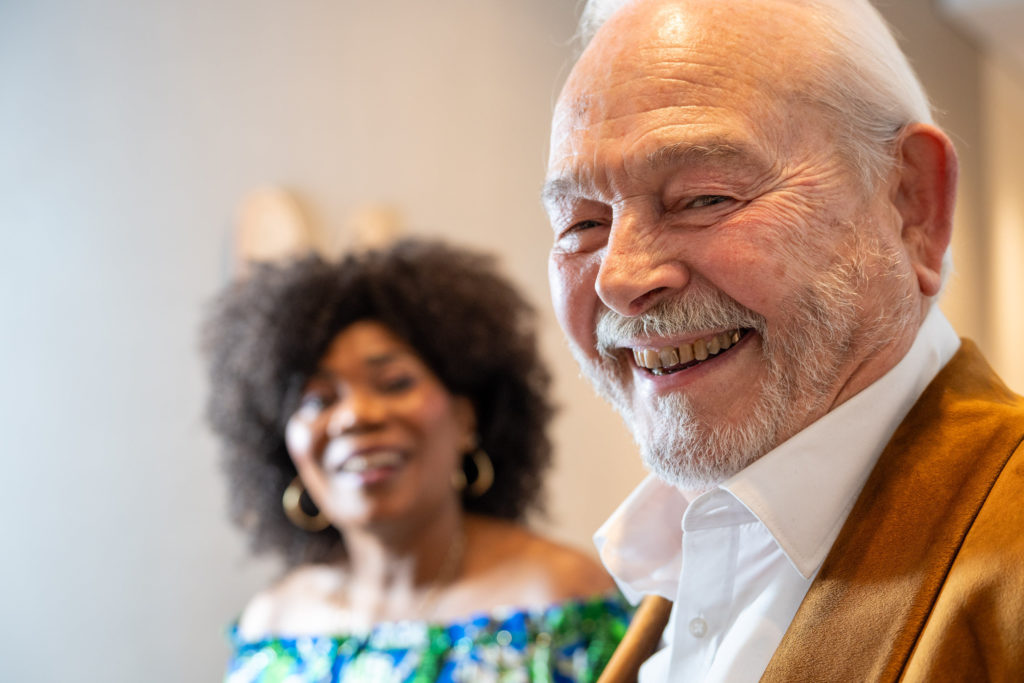

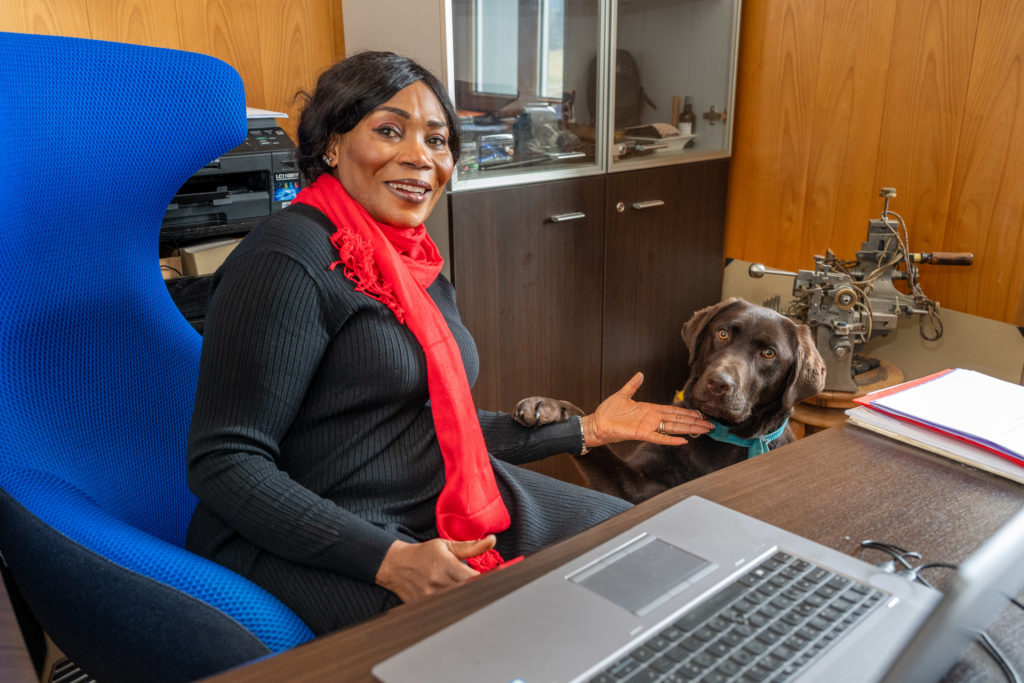
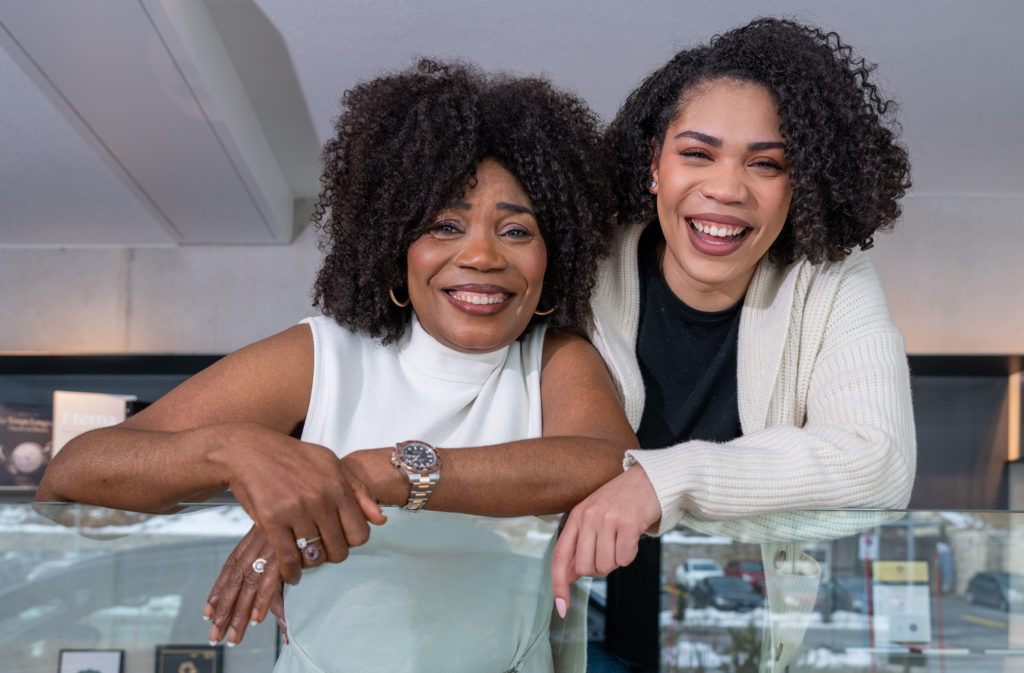
The Turning Point
One summer day in 2020, I had just completed the first piece of the limited Simplicity 20th Anniversary series—an exceptional timepiece, numbered 00/20, the result of decades of passion, precision, and perfectionism.
Filled with pride, I presented it to my wife, Élisabeth. The moment her eyes fell upon it, they lit up. She was captivated, utterly mesmerized by the beauty of this unique piece.
Then, without me noticing, she quietly left the workshop, the watch in hand.
As evening fell, a slight sense of unease began to creep in. I asked her:
— “What have you done with the watch?”
She looked me straight in the eye and, with unwavering confidence, replied:
— "I put it in the bank vault. I’ve decided to sell it at auction."
I was speechless. A heavy silence settled between us. My heart pounded under the weight of surprise and incomprehension. Never had I imagined such a fate for this piece—the very first of a series that celebrated an entire chapter of my journey.
But after a few moments of silent reflection, despite my reluctance, I eventually conceded:
— "Alright… you’re probably right. Let’s put it up for auction."
The big day arrived.
It was Sunday, November 8, 2020. The three of us—Élisabeth, our daughter Danièla, and I—gathered in our kitchen, watching the auction unfold on a simple laptop.
2:00 PM.
At Phillips in Geneva, the Simplicity went up for sale. The bidding started well above the experts’ estimates. Then, before our astonished eyes, the prices soared to dizzying heights.
The one-million mark was shattered.
The bids soared even higher.
Until they reached 1.36 million Swiss francs.
Un chiffre hallucinant. Un moment irréel.
As the euphoria faded, a wave of emotions overwhelmed me. After all these years of effort—so many doubts, sacrifices, and sleepless nights—the story of our workshop and our brand had just taken a decisive turn.
And all of it, I owed to Élisabeth.
She was the one who saw further than I did, who had the foresight and the boldness to make this decision.
I saw a watch.
She saw a historic moment.
It was her instinct, her tenacity, that defined this day—the day everything changed.
The Consecration
Throughout my career, I have received prestigious honors.
In 2013, I had the privilege of receiving the Gaïa Prize as well as the Special Jury Prize at the Grand Prix d’Horlogerie de Genève—distinctions that many consider the ultimate achievement in a watchmaker’s career.
But for me, the true crowning moment came later.
It was written into the history of auctions, where my timepieces reached unimaginable heights:
Pocket watch Grande Sonnerie: 2,329,000 CHF
Wristwatch Grande Sonnerie: 4,749,000 CHF and 7,600,000 CHF
Simplicity: 662,000 CHF and 756,000 CHF
Simplicity 20th anniversary at 1'360'000 CHF
Duality : 3’660’000 CHF
Dizzying figures that speak for themselves.
They are proof that there are still collectors and connoisseurs of haute horlogerie who recognize the value of meticulous craftsmanship, the time devoted to every detail, and the refusal to take shortcuts.
Throughout my journey, I have remained true to my principles.
Je n’ai jamais cédé aux chants des sirènes des investisseurs, des groupes industriels ou des financiers qui cherchaient à faire de moi une marque commerciale plutôt qu’un artisan.
I never paid attention to the jeers and mockery of marketing "experts" who told me that my approach was outdated, that independent watchmaking had no future.
I never followed trends, nor did I seek to please.
I simply did what I know best.
What I was born to do.
I am a watchmaker.
And I have remained one.


A Father's Pride
Some things cannot be forced. Invisible legacies passed down without a word, passions born in the quiet of a workshop—between the slanting light of a work lamp and the ticking of a movement coming to life.
Danièla, our daughter, grew up in this world—surrounded by tools shaped by my hands, timepieces patiently waiting under my loupe, and empty cases awaiting a soul. But I never pushed her to follow my path. Watchmaking is something you either have within you or you don’t.
And yet, from adolescence, something changed. Her gaze was no longer that of a mere enchanted spectator but of a keen observer, eager to understand. She asked precise questions, studied my movements with an intensity that spoke volumes.
While so many young people search for their path, hesitate, and stumble, Danièla already knew.
She wanted to be a watchmaker.
Her choice was unequivocal, and with unwavering determination, she joined the prestigious watchmaking school in Le Sentier. Her journey there was exemplary, driven by the same rigor and absolute dedication to excellence that have always guided me. In 2021, she earned her diploma, gaining the respect of her peers.
But a diploma does not make a watchmaker. Watchmaking is not learned solely in a classroom. Only hard work, precision, and excellence truly matter.
She then joined me in the workshop, and what could have been a simple transition became a defining moment. For throughout my career, I had never found a true successor—because there was no need to look elsewhere.
My own daughter was the one who would carry this legacy forward.
But she still had one final trial to face—an ultimate test that would determine whether she was truly worthy of entering this world where excellence allows no compromise.
She then created her very first wristwatch, entirely by her own hands. No longer just an exercise, but a true demonstration of the craftsmanship she had acquired from her master—her father. And this was no ordinary school watch; it was the ultimate culmination of her learning, the pinnacle of her apprenticeship. For it was nothing less than a Simplicity—a timepiece where every detail had to reach perfection, where even the slightest deviation was unthinkable. A watch that embodied the entirety of her training, crafted in the purest artisanal tradition, with the patience and precision of a true watchmaker. This timepiece was more than just an achievement—it was living proof of a successful transmission, a silent tribute to the one who had taught her everything.
A watch that, to be validated, had to withstand my uncompromising gaze.
In my workshop, nothing passes without absolute precision. Not a single detail can be overlooked, not a single imperfection tolerated. I subjected her work to the same rigorous judgment as I would any other watchmaker.
I examined every element from every angle.
I scrutinized every finish, every beveled edge, every polish, every adjustment.
And when I finally lifted my eyes to meet hers… I knew.
She had succeeded.
Her watch was perfect.
And at that precise moment, she was no longer just my daughter.
She was a watchmaker.
My pride as a father had never been greater.
But more than that, I knew that the future of our name and our independence was secure.
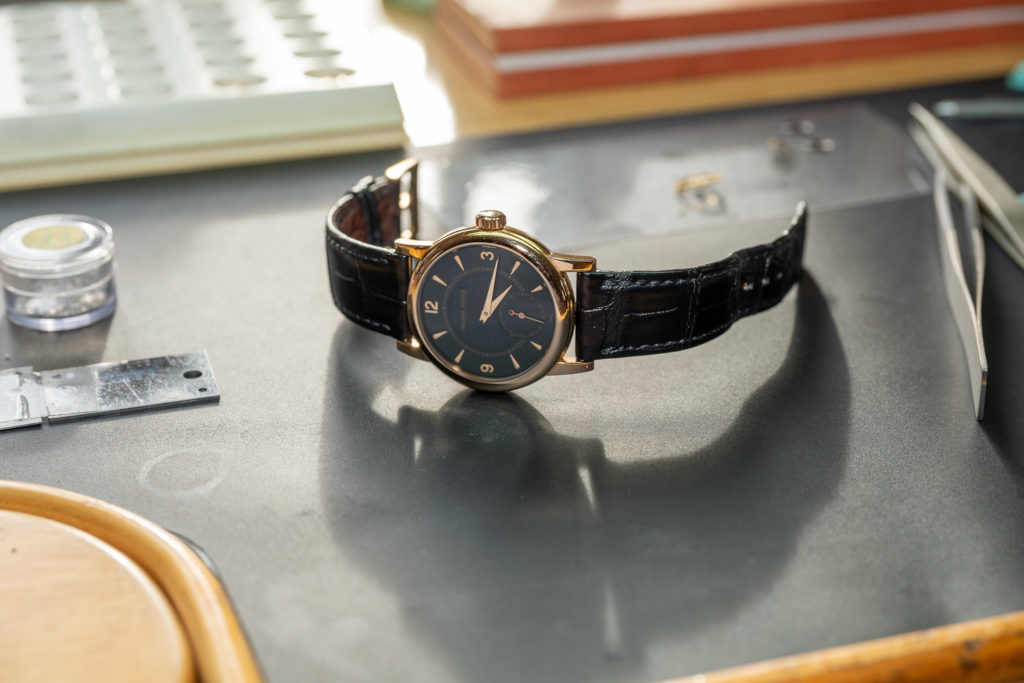
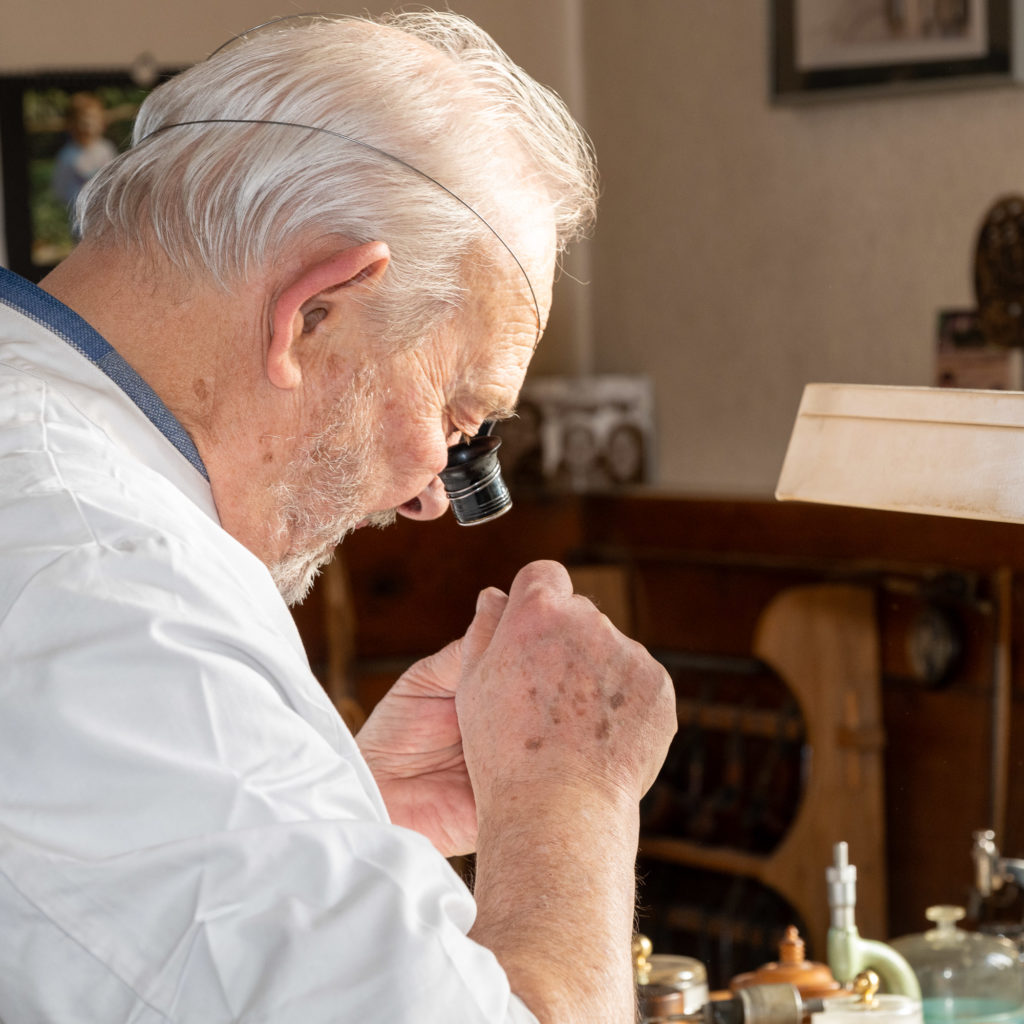
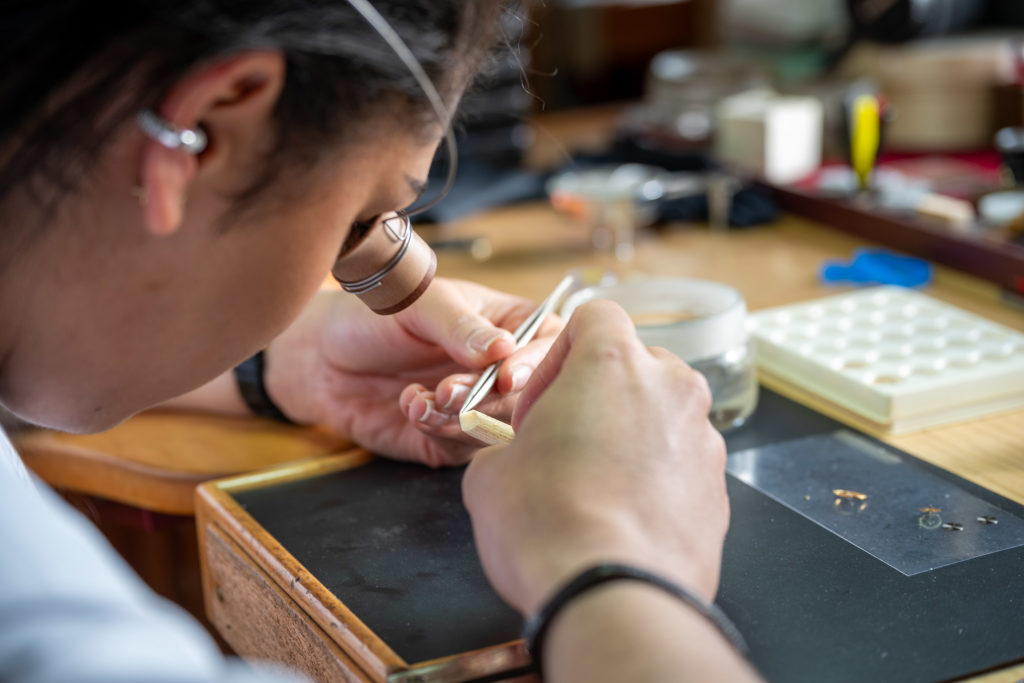

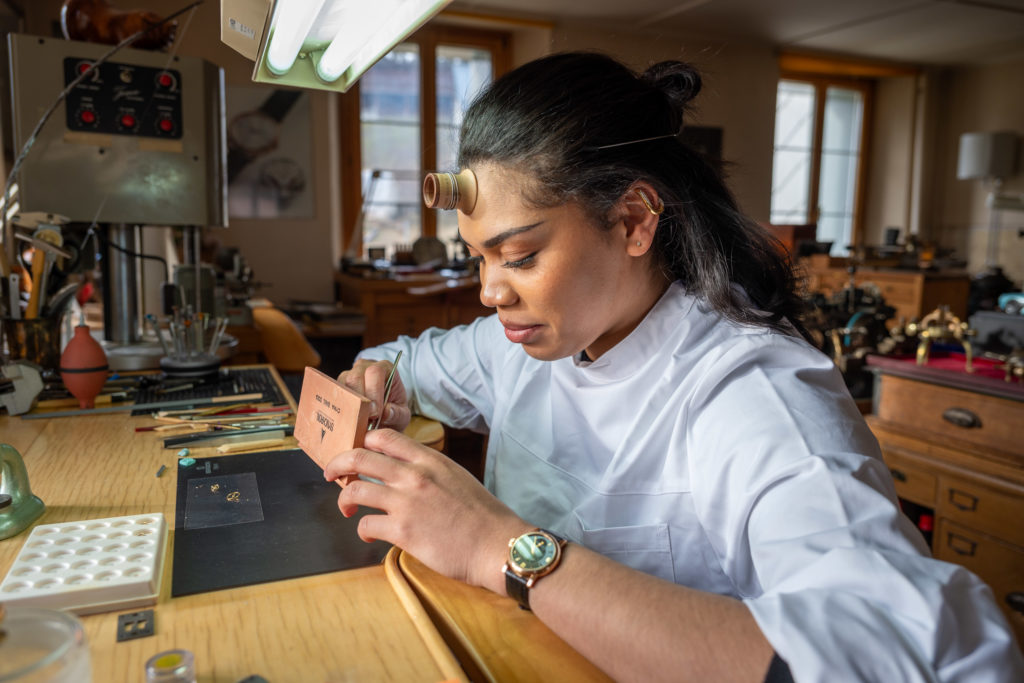
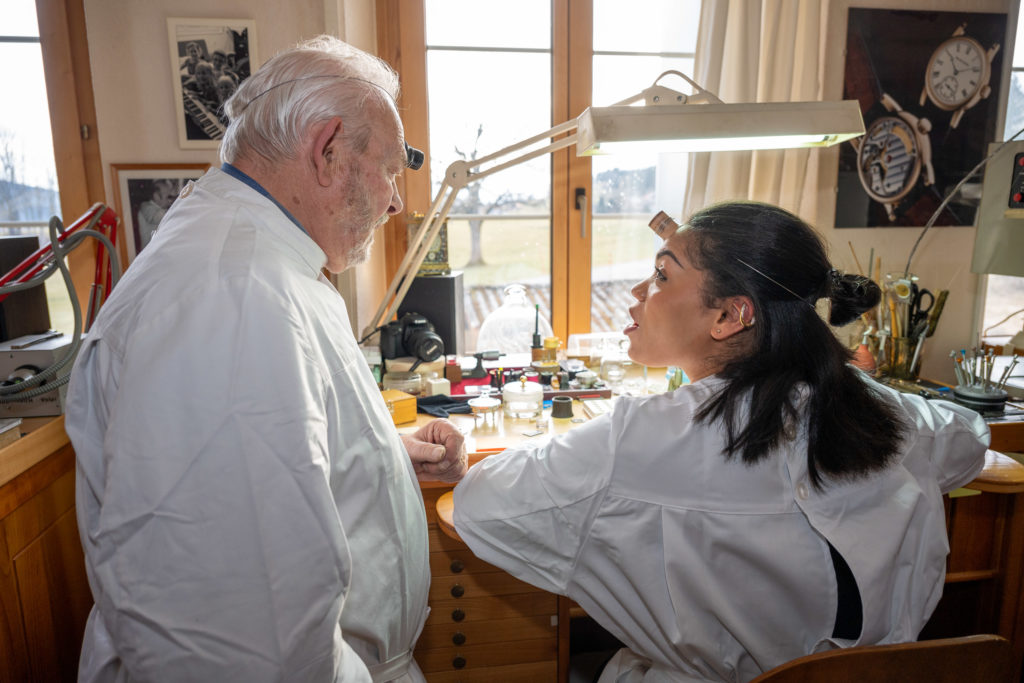
The Foundation: A Natural Commitment
There are things that cannot be bought—the love of fine craftsmanship, the passing down of knowledge, the desire to leave behind something greater than oneself. Throughout my life, these values have guided me, whether in watchmaking or beyond. And one day, it became clear that they needed to take another form, to be expressed differently. Thus, the Philippe & Élisabeth Dufour Foundation was born.
This initiative did not emerge from nowhere. It is the result of a deep conviction: that when life has given to you, you have a duty to give back. Watchmaking has taught me everything—patience, precision, and humility in the face of time. But what I have always known is that the greatest masterpiece is not measured solely by the perfection of a movement, but by the impact it leaves behind.
The idea of the Foundation emerged naturally, almost as an undeniable truth. Through our travels, encounters, and exchanges, we witnessed so many overlooked talents, so many forgotten artisans, so many skilled hands simply seeking a chance to express themselves. These hands—whether holding a tool, a brush, or a simple thread—deserved to be supported. It was not just about offering help, but about passing on knowledge, guiding, and restoring dignity to those who so often struggle in silence.
The first projects were driven by the desire to create something tangible and lasting. It was never about charity, but about respecting craftsmanship, creativity, and expertise. Watchmaking has taught me that a perfect work is never born from haste or chance, but from the care given to every detail. We wanted to apply this philosophy to the Foundation: to take our time, make thoughtful choices, and give meaning to every action.
With Élisabeth, we have always believed that the greatest achievements are not those that bear a name, but those that change lives. The Foundation is the extension of who we are, of what we have learned, and of what we wish to pass on. Every action taken, every project supported, is a promise: that dedication and excellence should not remain the privilege of a single world, but should be shared with those who need them most.
Today, looking back on the journey we have traveled, I know that this commitment goes far beyond us. It belongs to those who will carry it forward, to those who will continue to believe in it, to those who, one day, will pass it on in turn. Because watchmaking has taught me one final lesson: it is not just time that matters, but what we do with it.
Time, Legacy, and the Future
Watchmaking has taught me everything. But deep down, it is not just a story of watches—it is a story of time. A time we measure, shape, and refine, yet one that always slips through our fingers.
All my life, I have sought to understand this mystery. Time is not just a number on a dial—it is what we make of it. Every ticking of a movement is a promise, a testament to those who came before us and those who will follow. It is not about precision, complications, or materials. It is about legacy.
Creating a watch is about breathing meaning into a mechanical object. But that alone is not enough. The essence lies not only in the timepiece itself but in the hand that crafts it, the passion that drives it, and the humility of the one who understands that the true masterpiece is the one that endures, crossing generations without faltering.
Independence, which I have always defended, is a necessity. To be free is to remain true to one’s ethics, never betray one’s values, and refuse compromises. It is a battle—a struggle against a world where everything becomes standardized, predictable, and soulless. But this fight is not limited to watchmaking; it is universal. It concerns every artisan, every creator, every individual who refuses to bow to the dictates of convenience and the ephemeral.
Today, as I look at my workshop, my family, and the Foundation, I realize that everything I have built does not truly belong to me. My work, my watches, my craftsmanship—they are merely bridges to something greater. The essence is not in what we keep, but in what we pass on.
Because watchmaking is not an end in itself. It is a language, a philosophy, an act of resistance against a world that seeks to accelerate everything, to forget everything.
If this story carries one final message, it is this: never give in to ease. Do not let time slip away without leaving your mark upon it. True luxury is not found in the object itself, but in the time devoted to creating something beautiful, unique, and above all, sincere.
I am a watchmaker. But above all, I am a keeper of time.


